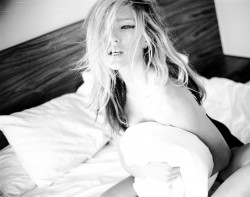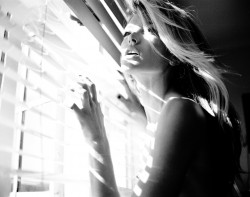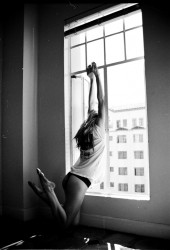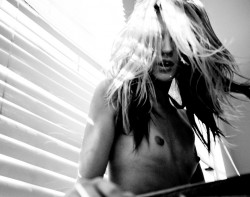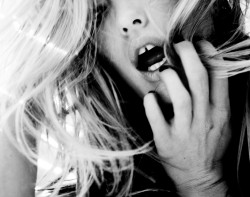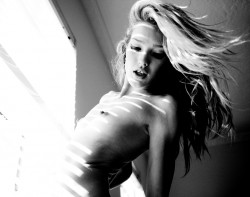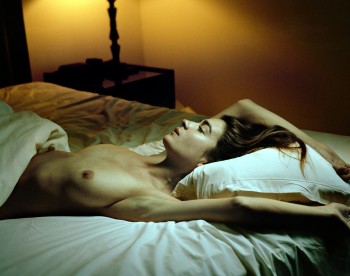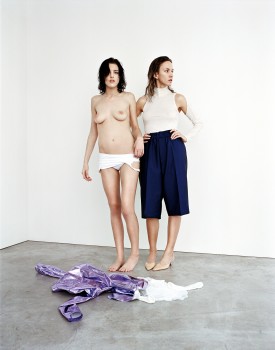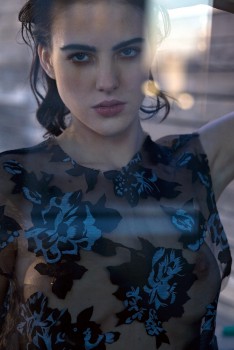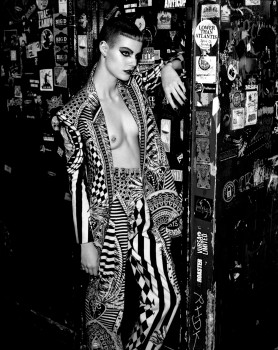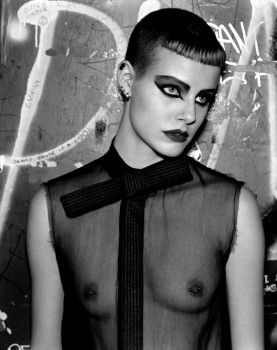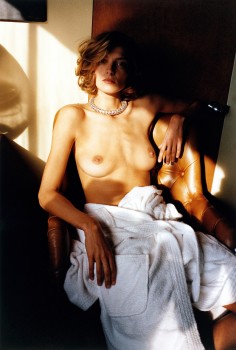* latest news on Sophie Turner's Panda Eyes (2013). Pretty much rules out nudity.
++++++++++++++++++++++++++++++++++++++++++++
Odette Annable makes her entrance in Episode 8
Banshee - Episode 1.08 - 1.10 - Press Releases
--Episode 08: “We Shall Live Forever”:Carrie urges Lucas to let go of the past, even as an increasingly suspicious Gordon is hell-bent on uncovering hers. Cast out of her Amish home, Rebecca turns to Proctor to give her a new start in Banshee. A surprise visit from Rabbit’s lieutenant, Olek, a.k.a. Widow’s Peak, brings back a flood of memories for Carrie. As his family keeps vigil for the ailing Benjamin Longshadow, Alex gets a surprise visit from his sister Nola. (Written by Jonathan Tropper and David Schickler; directed by Greg Yaitanes.)
Playdates: March 1, 2, 4, 5, 6 and 20
--Episode 09: “Always the Cowboy”:
As Rabbit closes in on Carrie and Lucas, Carrie flees the hospital in a desperate attempt to collect her family and get them out of town. Kai introduces Rebecca to the business world, and sends Lucas a message about fooling around with his niece. Alex Longshadow recruits a Proctor thug with gambling issues to deal with a work-stoppage problem at the casino. (Written by Jonathan Tropper and David Schickler; directed by Miguel Sapochnik.)
Playdates: March 8, 9, 11, 12, 13 and 20
--Episode 10: “A Mixture of Madness”: Season 1 finale.
Recalling a series of prison therapy sessions that fueled his hatred of Rabbit, and pressed by Xavier’s insistence that the FBI handle a kidnapping case, Lucas makes a decision that will change the collective fate of Carrie, her family, Sugar, Job, and the entire Banshee police force. A special delivery at Alex’s doorstep leads Nola to reconsider her future; Kai teaches Rebecca the power of telecommunications. (Written by Jonathan Tropper and David Schickler; directed by Miguel Sapochnik.)
Playdates: March 15, 16, 18, 19 and 20
 By the way Trieste Kelly Dunn first nude scene is closer than I thought (expected boobies in season 2). Maybe in tonight's Episode 5 or 6. As I have mentioned countless times before, there is real connection with social media and actress doing her first nude scene. 32-years old Trieste have started a Twitter account in late January (likely from her rep counsel) just weeks from her first topless scene and hopefully more. Can anyone care to confirm if she is from Mormon background?
By the way Trieste Kelly Dunn first nude scene is closer than I thought (expected boobies in season 2). Maybe in tonight's Episode 5 or 6. As I have mentioned countless times before, there is real connection with social media and actress doing her first nude scene. 32-years old Trieste have started a Twitter account in late January (likely from her rep counsel) just weeks from her first topless scene and hopefully more. Can anyone care to confirm if she is from Mormon background?Question: Banshee is just amazing and quickly becoming one of my favorite shows. As hot as Lucas and Carrie are, I’m more interested in Siobhan and Lucas and what’s in store for them. —Scott
Ausiello: Don’t miss this Friday’s episode. According to exec producer Greg Yaitanes, that’s when the pair’s “unexpected chemistry” will begin to “develop.” Bonus Scoop: There are more Season 2 clues in the Banshee Origins comic book.

Triesta is another of those actresses who has struggled to make something of herself in Hollywood and constantly failing due to own weakness and inflexibility. After more than a decade in the biz, you can say chickens have come home to roost. Keeping my fingers crossed Triesta will embrace her on-cam nudity the way Ivana has to surprise of everyone. Don't want to sound like a broken record but when nudity dodgers go sexy wild, they do it in the grandest style.
Charlotte Observer
For every Hollywood starlet like Anne Hathaway or Claire Danes, there are thousands of actresses trying to scrape together livings with a small guest spot on a TV show here, a low-paying role in an independent film there.
That’s been Trieste Kelly Dunn’s life since graduating from the University of North Carolina School of the Arts in 2004. Then along came 2012.
Last year, she landed roles on two high-profile TV series: Cinemax’s violence- and sex-filled “Banshee,” a first-year thriller that was shot in Charlotte and airs Fridays at 10 p.m., and the upcoming CBS crime drama “Golden Boy” (debuting Feb. 26).
“It’s definitely been an interesting eight years since I’ve been out of college,” says Dunn, who earned a Bachelor of Fine Arts from the Winston-Salem arts conservatory. “Some years are great. This year’s been the best, because I got to shoot a TV show in North Carolina for five months. What could be better than that? But yeah, then there have been years where I’ve just been like, ‘Why will nobody hire me?’ ”
Dunn, 31, plays small-town cop Siobhan Kelly on “Banshee”; as a regular cast member, she could be employed for years if her good fortune continues.
A native of Provo, Utah, Dunn moved to Southport at age 15. (“It’s a small fishing town. It’s very cute, it’s an adorable town, but it seems a little bit like a retirement town.”) After a year there, her mother moved her to Wilmington, where she attended New Hanover High School.
She graduated in 1999, then auditioned for UNCSA but didn’t get in, so kicked around New York City, Oregon and Utah for a year while waiting to try again.
“I always wanted to go there,” Dunn says. “I didn’t really care about Julliard or CalArts – I auditioned for both of those places, but for some reason I was hellbent on going to North Carolina School of the Arts. There’s just something really special about that place. It has a true feeling of artistic spirit. And it’s small, so you can really focus.”
“It was the best four years of my life.”
After earning her degree, she made a beeline for New York and started scraping. Over the years, she’s turned up in tiny parts on big TV series (“Law and Order: Special Victims Unit,” “Fringe,” “Brothers and Sisters”), and in big roles in tiny independent films made by UNSCA classmates Aaron Katz (“Cold Weather”), Brett Haley (“The New Year”) and Zach Clark (“Vacation!”). Dunn got some good notice for those 2010 movies – Filmmaker Magazine named her one of the “25 New Faces,” while the Los Angeles Times wrote a positive piece about her work – but still failed to break out.
Then last year, she successfully auditioned for a whacked-out new show about an ex-con and master thief who assumes the identity of the sheriff of organized-crime-ridden Banshee, Pa.
Executive produced by Alan Ball of “True Blood” fame and created by David Schickler and Jonathan Tropper, it’s a bloody, sexy, pulpy saga populated by Asian transvestites, Amish nymphomaniacs and sadistic slaughterhouse owners, among others. Dunn’s deputy may in fact be one of the sanest characters on the show (although everyone here seems to have secrets).
While the actress is fuzzy on whether “Banshee” is something she would watch if she weren’t on it – “women in general probably aren’t as fond of action and cool car chases and explosions and violence as men are” – she says being a part of the series has been a blast.
And Dunn will continue to be seen in her sheriff’s deputy uniform into 2014: On Tuesday, Cinemax renewed “Banshee” for a second season. (Producers have said crew could return to Charlotte as early as mid-February, although cast probably won’t report here till March.)
“It’s awesome. It’s all so fun,” she says of her “Banshee” experience. “I’d so much rather be working on a show like that, than working on a law show where I’m in the courtroom saying expository lines. I would so much rather be running around with a gun, yelling at people.”
++++++++++++++++++++++++++++++++++++++++++++

MACIEK KOBIELSKI'S WHITE NUDES
By JONATHAN SHIA
Maciek Kobielski has a talent for blurring the line between fashion and art photography. His images are striking and provocative, forcing his viewers into direct confrontation with his subjects, as in his stark, arresting image of Natasha Poly for our latest cover. In a new exhibition opening tonight, Kobielski adds a new twist to his body of work, with his “White Nudes” series, a contemporary take on classic nude portraiture. Featuring some of fashion’s top faces—including Hanne Gaby Odiele, Anaïs Pouliot, and Ros Georgiou—the images are sexy without being tawdry, iconic in their composition and modern æsthetic.“White Nudes” also serves as the latest edition of The Last Magazine‘s The Last Space, a physical exhibition and curated series of events celebrating the art, fashion, film, literature, and personal effects featured in the magazine. After bringing previous issues to life for Art Basel Miami Beach in 2010 and during New York Fashion Week in September 2011, The Last Space will continue to present the creative talents featured within our pages.
Maciek Kobielski’s “White Nudes” runs through February 17 at Gallery 131 1/2, 131 1/2 Chrystie Street, New York.
As one of the rising stars of photography, Maciek Kobielski is known for creating striking pictures that push fashion imagery into the realm of art. His newest project, a solo exhibition of new work entitled White Nudes, is set to debut at Gallery 131 ½, is an erotic series of nude portraits set against a white backdrop. Meant as an exploration of the “construction of the classic nude” Kobielski’s pictures featuring Anais Pouliot, Hanne Gaby Odiele, Kel Markey, Marie Piovesan and Ros Georgiou are raw, elegant and intimate. MDC caught up with the engaging Mr. Kobielski on the eve of his exhibition to discuss what inspired his latest work and what makes it so powerful.
What inspired you to do this series?
MK: Spending time with women. It was an experiment in direct documentation, to see what would happen with someone being absolutely open in her nudity.
These women don’t look vulnerable or fragile. They look strong and free.
MK: Exactly. I try to approach them with great care and as a result, the images are empowered.
Your pictures are known for being sexy. What’s sexy for you?
MK: I’m aware that many other people do not perceive these photographs as “sexy,” but to me they are extremely sexy. Being natural is sexy. These women are so refined that it is stunning.
Why did you shoot the nudes on a plain white background?
MK: I wanted people to see the drawing of the female figure. This background is for me like a fresh canvas.
As a painter as well as a photographer, do you think the White Nudes are really White Paintings?
MK: They feel to me like drawings. I don’t know how to draw, so for me the best way is to take the picture.
Is painting a higher art form than photography?
MK: I think so.
What defines your work?
MK: Color. I don’t use black and white at all. This way, it stays very contemporary. I try to see reality as close as possible. The people on the pictures are how I really see them.
What is the difference between showing your work in a gallery or as an editorial?
MK: It’s a different preparation. On this series, I worked for a period of time whereas an editorial is 1-2 days maximum. For the nudes, I worked with just with one person in a very stark reality, not a team creating an exterior artifice. For a magazine, you work with clothes, fashion, elements that are given. Taking away these elements makes the images pure so in this series there are no artifacts surrounding the portraits, the photos are stripped bare. It is the person and nothing else. Just the girl.
Are these images of woman or ideals?
MK: All of it. What’s really beautiful about these women is their purity.
After this show are you planning on doing a book?
MK: That’s the idea.
What other projecst are you interested in?
MK: There are so many interesting things coming in. Every project that I’ve recently brought to realization has been organic. All things that happen without planning have been fun.
WHITE NUDES is On view during New York
Fashion Week from February 7–17th 2013
At Gallery 131 1/2
131 1/2 Chrystie Street, New York NY 10002
++++++++++++++++++++++++++++++++++++++++++++
Maciek Kobielski’s “White Nudes” runs through February 17 at Gallery 131 1/2, 131 1/2 Chrystie Street, New York.
As one of the rising stars of photography, Maciek Kobielski is known for creating striking pictures that push fashion imagery into the realm of art. His newest project, a solo exhibition of new work entitled White Nudes, is set to debut at Gallery 131 ½, is an erotic series of nude portraits set against a white backdrop. Meant as an exploration of the “construction of the classic nude” Kobielski’s pictures featuring Anais Pouliot, Hanne Gaby Odiele, Kel Markey, Marie Piovesan and Ros Georgiou are raw, elegant and intimate. MDC caught up with the engaging Mr. Kobielski on the eve of his exhibition to discuss what inspired his latest work and what makes it so powerful.
What inspired you to do this series?
MK: Spending time with women. It was an experiment in direct documentation, to see what would happen with someone being absolutely open in her nudity.
These women don’t look vulnerable or fragile. They look strong and free.
MK: Exactly. I try to approach them with great care and as a result, the images are empowered.
Your pictures are known for being sexy. What’s sexy for you?
MK: I’m aware that many other people do not perceive these photographs as “sexy,” but to me they are extremely sexy. Being natural is sexy. These women are so refined that it is stunning.
Why did you shoot the nudes on a plain white background?
MK: I wanted people to see the drawing of the female figure. This background is for me like a fresh canvas.
As a painter as well as a photographer, do you think the White Nudes are really White Paintings?
MK: They feel to me like drawings. I don’t know how to draw, so for me the best way is to take the picture.
Is painting a higher art form than photography?
MK: I think so.
What defines your work?
MK: Color. I don’t use black and white at all. This way, it stays very contemporary. I try to see reality as close as possible. The people on the pictures are how I really see them.
What is the difference between showing your work in a gallery or as an editorial?
MK: It’s a different preparation. On this series, I worked for a period of time whereas an editorial is 1-2 days maximum. For the nudes, I worked with just with one person in a very stark reality, not a team creating an exterior artifice. For a magazine, you work with clothes, fashion, elements that are given. Taking away these elements makes the images pure so in this series there are no artifacts surrounding the portraits, the photos are stripped bare. It is the person and nothing else. Just the girl.
Are these images of woman or ideals?
MK: All of it. What’s really beautiful about these women is their purity.
After this show are you planning on doing a book?
MK: That’s the idea.
What other projecst are you interested in?
MK: There are so many interesting things coming in. Every project that I’ve recently brought to realization has been organic. All things that happen without planning have been fun.
WHITE NUDES is On view during New York
Fashion Week from February 7–17th 2013
At Gallery 131 1/2
131 1/2 Chrystie Street, New York NY 10002
++++++++++++++++++++++++++++++++++++++++++++
Model: ravishing Jewish babe Shir Elmaliach
++++++++++++++++++++++++++++++++++++++++++++
Milkana: Sexy Lingerie Photoshoot by Pavel Badzhakov | FashionTV HOT
from Pavel BadzhakovModel: Milkana Kamisheva
++++++++++++++++++++++++++++++++++++++++++++
purple INTERVIEW : S/S 2013 issue 19
LARRY CLARK - marfa girl
interview by OLIVIER ZAHM
portrait by PIETRO PESCHE
pictures extracted from MARFA GIRL
After working for 50 years as a visual artist — in photography, collage, film, books, and installation art — the 70-year-old American artist Larry Clark has never been more productive, nor has he ever felt so free and inspired. His energy seems to rival that of the kids of this generation. This may be due to his natural affinity to youth as well as his respect for them. Larry Clark may steal their energy, but he has never sold them or himself out, whether to commercial or financial interests. He’s a role model for them and for anyone who refuses to conform.
His latest film, Marfa Girl, shot in the small town of Marfa, Texas is a revelation in American contrasts. Decades ago, New York artist Donald Judd transformed an Army fort in Marfa into what became an outpost of a Minimalist Art. Despite the art connection, the town of Marfa, located just 68 miles from the Mexican border, is a bastion of conservatism, with 11 o’clock curfews for young adults, spanking of children in schools, rampant racial suspicion between Whites and Latinos, and police surveillance. It’s also the headquarters of the West Texas border patrol.
Clark has always made films about teenagers on the edge of society, chasing the “American Dream,” but trapped in the radar of cultural control, such as the 14-year-olds he met in Marfa, whose story about local realities are seen through the eyes of a boy named Adam and an unnamed “Marfa Girl,” an artist from the sophisticated, and in Adam’s eyes, otherworldly New York City.
We met Larry Clark in New York the day before he flew to Rome, where he showed his film at the Rome Film Festival, and where won the award for Best Film. But Marfa Girl is now shown exclusively on Clark’s website, larryclark.com. Why? Because the studio-run Hollywood censorship board refused give his film a rating. We asked him about that.
OLIVIER ZAHM — How do you feel these days?
LARRY CLARK — I feel good. I’ve done more work this year than I’ve probably done in any other year of my life. I started out the year making photographs, and then in a frenzy, I made 18 big collages.
OLIVIER ZAHM — Collages of your photographs?
LARRY CLARK — Yes. I had all these color 5x7s. I did two big collages of the actor Brad Renfro, who passed away a few years ago and was really disrespected by Hollywood. He was the star of my movie Bully. I knew him well. He had a lot of issues with drugs and alcohol. When they did the in memoriam at the Academy Awards, they gave five minutes to Heath Ledger. He was up for an Oscar and he had OD’d on prescription drugs. But Brad had OD’d on heroin, so they didn’t even mention him. They mentioned Frank Sinatra’s publicist and didn’t even mention Brad Renfro. I got so pissed off. When the press asked about it, a spokesman said, “Well, we can’t mention everybody.” I mean, it was just the biggest insult. So I did these in homage to him. They’re all photographs of him right at his 18th birthday. They were just shown in Berlin.
OLIVIER ZAHM — Beautiful. Are they big pieces?
LARRY CLARK — One is like 4x8 feet and the other one is double that size, so very big. After doing the collages, I went to Marfa, Texas, to see a friend of mine, the painter Christopher Wool, and his wife Charline von Heyl. I met this kid there, who was 15 and he was a skateboarder. There were about three skateboarders in town because it’s really flat, there’s no place to skate, and I was inspired to make a film. So seven months later I got the money to make it and I wrote a screenplay.
OLIVIER ZAHM — What was it that struck you about this kid?
LARRY CLARK — Someone had told me a story about him that turned out not to be true at all. But the story got my mind thinking. And the story was that this kid, who was 14 or 15 years old, had a 28-year-old girlfriend who was pregnant. And they were going to have the kid. I said, “Well what do the families think about this?” They said, “Oh, the families are OK with it.” There’s no abortion, it’s all very Christian.
OLIVIER ZAHM — There is also a culture clash in Marfa.
LARRY CLARK — Marfa is full of white people, like cowboys, ranchers … just white people. There are also Mexican-Americans, who were born and raised there. It’s 68 miles from the border. The border patrol headquarters is there, so it’s swarming with border patrol agents, but it’s still 68 miles from the border, so the agents fuck with the locals. I mean it’s horrible. They fuck with the kids, and if you happen to be brown, Mexican-American, born and raised there, they stop you and ask you for your papers, even though you were born and raised there. And it’s a tiny little town. There are 1,800 people. Donald Judd discovered it. His foundation and library are there. So there are Mexican-American locals, there are the white locals, and now there’s the art crowd. Somedays you look around and you think you’re in Chelsea.
OLIVIER ZAHM — Do these groups coexist well?
LARRY CLARK — They live together, but it’s a culture clash. That’s why I was inspired to write a film about it. The bad guy is a border patrol agent. I really make him bad. You’ve never seen a badder guy than this guy.
OLIVIER ZAHM — Did you cast a real agent?
LARRY CLARK — Oh no, this is an actor. I cast professionals from Austin, which is about seven hours away. They have a very good acting pool there. And then I cast local kids from Marfa. If you look on the website, you’ll see Adam Mediano and Mercedes Maxwell. Adam was the one I heard this story about, which turned out not to be true. He plays the ingenue. Everything happens to him. He witnesses everything. He and Mercedes are both 16 — I decided to give him an age-appropriate girlfriend. And then there’s the actual Marfa girl, played by Drake Burnette. She’s an artist in residence at the Donald Judd Foundation at Chinati.
OLIVIER ZAHM — What was your process making this movie, from idea to end result?
LARRY CLARK — The initial spark was the character of Adam and his pregnant girlfriend. I sketched out all these ideas in this little notebook and went to LA. I saw someone I know who has money and pitched it to him. I kept telling him what was in the notebook, but I wouldn’t show it to him. And he said, “OK, I’ll give you the money to make the movie.” I wanted to make it with small digital cameras because you can do miracles with those things. So it wasn’t that expensive. The budget was $450,000. We’ve probably spent about $700,000 now with post-production and everything, but the quality is incredible.
OLIVIER ZAHM — What did you shoot with?
LARRY CLARK — Canon 5Ds. They’re amazing. I had a very good crew from Los Angeles come in. My cinematographer and everybody came from LA, and I cast professionals out of Austin and local people from Marfa. We got ready to shoot and they said, “Well look, we have to have a script to schedule it,” like what day to be where, and I said OK. So I wrote a 25-page script that was double-spaced, I stretched it into 25 pages; it was very hard. I gave them just enough to schedule the film. Every morning I would wake up at five o’clock and I would write like mad. It was very organic that way.
OLIVIER ZAHM — Where did you stay in Marfa?
LARRY CLARK — So Mary Farley — who used to be married to Matthew Barney, and whom I’ve known for over 20 years — lives in Marfa, and she likes birds. She has chickens and fresh eggs and parrots and birds everywhere. She doesn’t fly because she has to take her birds with her when she travels. I’m not kidding. I was going to stay in the casita behind the main house, but Mary was in Austin visiting her boyfriend for a long time. I had the main house, the casita and the chickens.
OLIVIER ZAHM — And the birds.
LARRY CLARK — No, no, no, she took her parrots with her, but the chickens stayed. Every morning I would go out and get two warm, wonderful fresh eggs from the chickens. I was writing, and so I wrote Mary into the script. She plays Adam’s mother. Adam’s chore is to get the eggs.
OLIVIER ZAHM — What else drew you to Marfa? There is definitely something in the air in this town.
LARRY CLARK — There are all these things. Marfa is where they shot Giant in the 1950s. That was James Dean’s last movie, with Elizabeth Taylor and Rock Hudson.
OLIVIER ZAHM — There’s something in the air.
LARRY CLARK — Yes. Donald Judd discovered the place when he got out of the Army — he was in Korea in the ’50s — and passed through it on a bus. He came back years later with a grant from the Dia Foundation and bought this Army fort. He turned the barracks and mess halls into permanent galleries. There’s a gallery for Dan Flavin, there’s a permanent gallery in town with John Chamberlain’s sculptures from the ’70s, which is amazing. There are about 40 of his sculptures in the middle of the town.
OLIVIER ZAHM — How long did it take to shoot the film?
LARRY CLARK — I shot the whole film in 19 days. During that time I had one day off, when I did a fashion shoot for V to promote the film. They were doing an Americana issue, so they called and said, “Would you be interested in doing something?” I said, “I’m in Texas making a movie!” So they sent all these fashion people down with racks of clothes, and I did a fashion shoot with the kids from the movie. I had no days off. I just kept working. It was pretty crazy.
OLIVIER ZAHM — Where will I be able to see the movie?
LARRY CLARK — On larryclark.com, which was built for this movie. The only way anybody can ever see my movie is to go to larryclark.com and stream it. For $5.99 you get the film for 24 hours. That way we cut out all the crooked distributors and Hollywood bullshit. I’m the first filmmaker to do this, I think. There are probably three or four filmmakers in the world who could do this and get away with it. There are people waiting for my films. I have a following because I’m so old and I’ve been doing this for so long. I think this is the future, because the small theaters that show indie movies and art movies are disappearing. Everything is going digital, and they can’t afford to switch over. Plus, I’ve noticed that everybody under 35 watches all their media on their computer, on their laptop. So why not go straight to them? They don’t watch TV, and they only go to the movies when there’s a blockbuster movie as a social event with 12 of their friends. It’s not really going to the movies, it’s a social event. They all go see Batman or something. The small theaters that show the art movies are a thing of the past, so I’m a pioneer and I think this is going to work. This is what all the young filmmakers are going to start doing. I’m leading the way.
LARRY CLARK — Marfa is full of white people, like cowboys, ranchers … just white people. There are also Mexican-Americans, who were born and raised there. It’s 68 miles from the border. The border patrol headquarters is there, so it’s swarming with border patrol agents, but it’s still 68 miles from the border, so the agents fuck with the locals. I mean it’s horrible. They fuck with the kids, and if you happen to be brown, Mexican-American, born and raised there, they stop you and ask you for your papers, even though you were born and raised there. And it’s a tiny little town. There are 1,800 people. Donald Judd discovered it. His foundation and library are there. So there are Mexican-American locals, there are the white locals, and now there’s the art crowd. Somedays you look around and you think you’re in Chelsea.
OLIVIER ZAHM — Do these groups coexist well?
LARRY CLARK — They live together, but it’s a culture clash. That’s why I was inspired to write a film about it. The bad guy is a border patrol agent. I really make him bad. You’ve never seen a badder guy than this guy.
OLIVIER ZAHM — Did you cast a real agent?
LARRY CLARK — Oh no, this is an actor. I cast professionals from Austin, which is about seven hours away. They have a very good acting pool there. And then I cast local kids from Marfa. If you look on the website, you’ll see Adam Mediano and Mercedes Maxwell. Adam was the one I heard this story about, which turned out not to be true. He plays the ingenue. Everything happens to him. He witnesses everything. He and Mercedes are both 16 — I decided to give him an age-appropriate girlfriend. And then there’s the actual Marfa girl, played by Drake Burnette. She’s an artist in residence at the Donald Judd Foundation at Chinati.
OLIVIER ZAHM — What was your process making this movie, from idea to end result?
LARRY CLARK — The initial spark was the character of Adam and his pregnant girlfriend. I sketched out all these ideas in this little notebook and went to LA. I saw someone I know who has money and pitched it to him. I kept telling him what was in the notebook, but I wouldn’t show it to him. And he said, “OK, I’ll give you the money to make the movie.” I wanted to make it with small digital cameras because you can do miracles with those things. So it wasn’t that expensive. The budget was $450,000. We’ve probably spent about $700,000 now with post-production and everything, but the quality is incredible.
OLIVIER ZAHM — What did you shoot with?
LARRY CLARK — Canon 5Ds. They’re amazing. I had a very good crew from Los Angeles come in. My cinematographer and everybody came from LA, and I cast professionals out of Austin and local people from Marfa. We got ready to shoot and they said, “Well look, we have to have a script to schedule it,” like what day to be where, and I said OK. So I wrote a 25-page script that was double-spaced, I stretched it into 25 pages; it was very hard. I gave them just enough to schedule the film. Every morning I would wake up at five o’clock and I would write like mad. It was very organic that way.
OLIVIER ZAHM — Where did you stay in Marfa?
LARRY CLARK — So Mary Farley — who used to be married to Matthew Barney, and whom I’ve known for over 20 years — lives in Marfa, and she likes birds. She has chickens and fresh eggs and parrots and birds everywhere. She doesn’t fly because she has to take her birds with her when she travels. I’m not kidding. I was going to stay in the casita behind the main house, but Mary was in Austin visiting her boyfriend for a long time. I had the main house, the casita and the chickens.
OLIVIER ZAHM — And the birds.
LARRY CLARK — No, no, no, she took her parrots with her, but the chickens stayed. Every morning I would go out and get two warm, wonderful fresh eggs from the chickens. I was writing, and so I wrote Mary into the script. She plays Adam’s mother. Adam’s chore is to get the eggs.
OLIVIER ZAHM — What else drew you to Marfa? There is definitely something in the air in this town.
LARRY CLARK — There are all these things. Marfa is where they shot Giant in the 1950s. That was James Dean’s last movie, with Elizabeth Taylor and Rock Hudson.
OLIVIER ZAHM — There’s something in the air.
LARRY CLARK — Yes. Donald Judd discovered the place when he got out of the Army — he was in Korea in the ’50s — and passed through it on a bus. He came back years later with a grant from the Dia Foundation and bought this Army fort. He turned the barracks and mess halls into permanent galleries. There’s a gallery for Dan Flavin, there’s a permanent gallery in town with John Chamberlain’s sculptures from the ’70s, which is amazing. There are about 40 of his sculptures in the middle of the town.
OLIVIER ZAHM — How long did it take to shoot the film?
LARRY CLARK — I shot the whole film in 19 days. During that time I had one day off, when I did a fashion shoot for V to promote the film. They were doing an Americana issue, so they called and said, “Would you be interested in doing something?” I said, “I’m in Texas making a movie!” So they sent all these fashion people down with racks of clothes, and I did a fashion shoot with the kids from the movie. I had no days off. I just kept working. It was pretty crazy.
OLIVIER ZAHM — Where will I be able to see the movie?
LARRY CLARK — On larryclark.com, which was built for this movie. The only way anybody can ever see my movie is to go to larryclark.com and stream it. For $5.99 you get the film for 24 hours. That way we cut out all the crooked distributors and Hollywood bullshit. I’m the first filmmaker to do this, I think. There are probably three or four filmmakers in the world who could do this and get away with it. There are people waiting for my films. I have a following because I’m so old and I’ve been doing this for so long. I think this is the future, because the small theaters that show indie movies and art movies are disappearing. Everything is going digital, and they can’t afford to switch over. Plus, I’ve noticed that everybody under 35 watches all their media on their computer, on their laptop. So why not go straight to them? They don’t watch TV, and they only go to the movies when there’s a blockbuster movie as a social event with 12 of their friends. It’s not really going to the movies, it’s a social event. They all go see Batman or something. The small theaters that show the art movies are a thing of the past, so I’m a pioneer and I think this is going to work. This is what all the young filmmakers are going to start doing. I’m leading the way.
OLIVIER ZAHM — But aren’t you nostalgic for the big screen?
LARRY CLARK — Well, I mean, of course, but what are you going to do? There’ll be no theaters to show film anymore. You gotta move ahead. You gotta keep moving man. Of course I love film and I love 35mm, but if there’s no place to show it… Even if you do shoot in film, they’re going to digitize it anyway. Plus the equipment is getting so good now. You know the great film camera, Arriflex, has finally made a digital camera called the Alexa which is comparable to 35 mm film. That’s what people are using now and it’s amazing. The problem with digital at the beginning was you couldn’t shoot with shadow and light at the same time, but now there’s latitude like film.
OLIVIER ZAHM — Does putting it online get around the issue of censorship?
LARRY CLARK — If I put this film out regularly, I would never get a rating. There’d be two theaters in the United States that would show it: one in New York and maybe one in California, and that would be it. It would be unrated and it would be ridiculous. But on the Internet, the kids see everything, they see pornography. All they have to do is push a button saying I’m 18, so this is it. The idea really came to me because I have this 22-minute short film called Jonathan that everybody’s afraid to show. I asked to have a special screening at Cannes and I talked to the director of the festival, Thierry Frémaux, who, by the way, turned down Ken Park and has rued the day ever since. I told him I didn’t want to be in competitions, I just wanted to screen this little 22-minute film and they were afraid to do it.
OLIVIER ZAHM — What is it about?
LARRY CLARK — It’s about Jonathan Velasquez, who was in Wassup Rockers, and who has a band in Los Angeles now called reVolt. Terrific band. And the film is Jonathan at 14 and at 21. We switch back and forth. He’s talking about the future when he’s 14, and we show him at 21. They’re all afraid to show it.
OLIVIER ZAHM — Why?
LARRY CLARK — You’ll see. After Marfa Girl, I’ll put it on larryclark.com. You’ve never seen anything like it.
OLIVIER ZAHM — So Marfa Girl is just the beginning?
LARRY CLARK — I’ll keep going. It’s a trilogy. Next April I’m going to shoot Marfa Girl II, and one year later I’ll shoot Marfa Girl III. I’m writing the second one now.
OLIVIER ZAHM — Can you tell us about the Marfa girl from the film’s title, Drake Burnette?
LARRY CLARK — She’s great in this film. She was born in Texas. I couldn’t find the right girl to play the Marfa girl and a friend of mine, Jim Lewis, insisted I call her. She was living with her boyfriend in Louisiana. I Skyped her and we talked for about four hours. I cast her on Skype. I said, “Get in a car and drive to Marfa, we’re shooting.” She was perfect. I told her what she had to do. I told her everything. I don’t trick people, I tell them. I said, you know, there’s a lot of nudity. You have to be comfortable with your body. You have to be comfortable walking around naked a lot, and she was. She’s absolutely amazing.
OLIVIER ZAHM — There’s a lot of nudity and sex in this film?
LARRY CLARK — Well, yes, of course. It’s my film, what do you think?
OLIVIER ZAHM — We are in such a dark political situation. Abortion is now a political issue. What’s going on in America today?
LARRY CLARK — The country’s a 50/50 split. You’re out in California and New York. Go into the provinces and it’s a totally different world. The Republicans want to go backward. Oklahoma, where I was born and raised, went for Bush more than any other state in the union. Driving around Texas, the radio is anti-Obama 24 hours a day. I’ve heard shows where the whole thing is: Wait 10 years and you’re going to find out the truth about Obama. You’re going to find out the truth about what’s really going on. He’s the devil incarnate. What the fuck is that about? I mean that’s some crazy shit to say to get people against Obama. It’s complete nonsense. And the main reason that the people don’t like Obama is because he’s black. That’s the reason. They can’t imagine having a black president and the Republicans, en masse, just say no to everything.
OLIVIER ZAHM — But Texas and the “real” America have always been very conservative.
LARRY CLARK — That’s America and that’s the way it is. In the ’60s, everybody thought that was the way it was going to be, and it turned out to be an aberration, right? It wasn’t the way it was going to be. It was just a period. The pendulum swings back and forth. America has been divided for a while.
OLIVIER ZAHM — How can kids accept this situation?
LARRY CLARK — It’s their world. It’s not my world anymore. It’s their world and they’ll figure it out and survive. I just wrote a little bio about Adam and Mercedes for the press kit for the Rome Film Festival. I said Adam’s dream is to be an actor and her dream, since she was five years old, was to be a model.
OLIVIER ZAHM — They dreamed of escape.
LARRY CLARK — Yes, the main dream is to get the hell out of West Texas. You know, driving into Marfa, you go to El Paso, you drive for three and a half hours and then you make a right and it’s 60 more miles. Just before you make that right, on the American side, they stop every car. They have dogs, they have masks on, they have AK-47s and they say, “Are you American?’ and if you happen not to be an American or happen to be brown, you’ve got to show your papers. Christopher Wool was driving through in a rented car, and because it was a rental, they stopped him. They took the car apart. He said, “What the hell are you looking for?” And then Charline, who is German and has a green card, they detained her for a couple of hours doing a background check. It’s crazy. And if you happen to be brown, just get ready to be stopped. They’re going to search your car, you’re going to have to show papers, they’re going to look for drugs. This is on the American side. Is that even legal? I don’t think that’s fucking legal, man. Every car gets stopped.
OLIVIER ZAHM — It’s like a war zone.
LARRY CLARK — It’s totally nuts. Jeff Elrod, who’s a very fine painter, drove out of Marfa one day and then remembered something and had to come back. He gets stopped by a border patrol, and usually he would just tell the guy to fuck off, but he was in a pretty good mood and so he started talking to the guy, and he said, “Why did you stop me?” But in a friendly way, and the border patrol guy said that when somebody goes out of town and then turns around they stop them. They’re watching everybody. They have a drone blimp that’s over the town so they can see everybody. They can also see the border and they have infrared, and so if someone goes out of town and turns around, they think that they’re either picking up drugs that have been left there for them, a bundle of marijuana or something, weed, or they’re picking up an illegal. And so Jeff starts talking to the guy and he says, “You’re looking for illegals and drugs all the time?” The guy looked at him straight in the eye and sincerely said, “We’re really waiting for al-Qaeda.” I mean… They pledge allegiance to the flag of Texas every morning. They pledge allegiance to the United States of America and then to Texas. And they still have corporal punishment in Marfa.
LARRY CLARK — Well, I mean, of course, but what are you going to do? There’ll be no theaters to show film anymore. You gotta move ahead. You gotta keep moving man. Of course I love film and I love 35mm, but if there’s no place to show it… Even if you do shoot in film, they’re going to digitize it anyway. Plus the equipment is getting so good now. You know the great film camera, Arriflex, has finally made a digital camera called the Alexa which is comparable to 35 mm film. That’s what people are using now and it’s amazing. The problem with digital at the beginning was you couldn’t shoot with shadow and light at the same time, but now there’s latitude like film.
OLIVIER ZAHM — Does putting it online get around the issue of censorship?
LARRY CLARK — If I put this film out regularly, I would never get a rating. There’d be two theaters in the United States that would show it: one in New York and maybe one in California, and that would be it. It would be unrated and it would be ridiculous. But on the Internet, the kids see everything, they see pornography. All they have to do is push a button saying I’m 18, so this is it. The idea really came to me because I have this 22-minute short film called Jonathan that everybody’s afraid to show. I asked to have a special screening at Cannes and I talked to the director of the festival, Thierry Frémaux, who, by the way, turned down Ken Park and has rued the day ever since. I told him I didn’t want to be in competitions, I just wanted to screen this little 22-minute film and they were afraid to do it.
OLIVIER ZAHM — What is it about?
LARRY CLARK — It’s about Jonathan Velasquez, who was in Wassup Rockers, and who has a band in Los Angeles now called reVolt. Terrific band. And the film is Jonathan at 14 and at 21. We switch back and forth. He’s talking about the future when he’s 14, and we show him at 21. They’re all afraid to show it.
OLIVIER ZAHM — Why?
LARRY CLARK — You’ll see. After Marfa Girl, I’ll put it on larryclark.com. You’ve never seen anything like it.
OLIVIER ZAHM — So Marfa Girl is just the beginning?
LARRY CLARK — I’ll keep going. It’s a trilogy. Next April I’m going to shoot Marfa Girl II, and one year later I’ll shoot Marfa Girl III. I’m writing the second one now.
OLIVIER ZAHM — Can you tell us about the Marfa girl from the film’s title, Drake Burnette?
LARRY CLARK — She’s great in this film. She was born in Texas. I couldn’t find the right girl to play the Marfa girl and a friend of mine, Jim Lewis, insisted I call her. She was living with her boyfriend in Louisiana. I Skyped her and we talked for about four hours. I cast her on Skype. I said, “Get in a car and drive to Marfa, we’re shooting.” She was perfect. I told her what she had to do. I told her everything. I don’t trick people, I tell them. I said, you know, there’s a lot of nudity. You have to be comfortable with your body. You have to be comfortable walking around naked a lot, and she was. She’s absolutely amazing.
OLIVIER ZAHM — There’s a lot of nudity and sex in this film?
LARRY CLARK — Well, yes, of course. It’s my film, what do you think?
OLIVIER ZAHM — We are in such a dark political situation. Abortion is now a political issue. What’s going on in America today?
LARRY CLARK — The country’s a 50/50 split. You’re out in California and New York. Go into the provinces and it’s a totally different world. The Republicans want to go backward. Oklahoma, where I was born and raised, went for Bush more than any other state in the union. Driving around Texas, the radio is anti-Obama 24 hours a day. I’ve heard shows where the whole thing is: Wait 10 years and you’re going to find out the truth about Obama. You’re going to find out the truth about what’s really going on. He’s the devil incarnate. What the fuck is that about? I mean that’s some crazy shit to say to get people against Obama. It’s complete nonsense. And the main reason that the people don’t like Obama is because he’s black. That’s the reason. They can’t imagine having a black president and the Republicans, en masse, just say no to everything.
OLIVIER ZAHM — But Texas and the “real” America have always been very conservative.
LARRY CLARK — That’s America and that’s the way it is. In the ’60s, everybody thought that was the way it was going to be, and it turned out to be an aberration, right? It wasn’t the way it was going to be. It was just a period. The pendulum swings back and forth. America has been divided for a while.
OLIVIER ZAHM — How can kids accept this situation?
LARRY CLARK — It’s their world. It’s not my world anymore. It’s their world and they’ll figure it out and survive. I just wrote a little bio about Adam and Mercedes for the press kit for the Rome Film Festival. I said Adam’s dream is to be an actor and her dream, since she was five years old, was to be a model.
OLIVIER ZAHM — They dreamed of escape.
LARRY CLARK — Yes, the main dream is to get the hell out of West Texas. You know, driving into Marfa, you go to El Paso, you drive for three and a half hours and then you make a right and it’s 60 more miles. Just before you make that right, on the American side, they stop every car. They have dogs, they have masks on, they have AK-47s and they say, “Are you American?’ and if you happen not to be an American or happen to be brown, you’ve got to show your papers. Christopher Wool was driving through in a rented car, and because it was a rental, they stopped him. They took the car apart. He said, “What the hell are you looking for?” And then Charline, who is German and has a green card, they detained her for a couple of hours doing a background check. It’s crazy. And if you happen to be brown, just get ready to be stopped. They’re going to search your car, you’re going to have to show papers, they’re going to look for drugs. This is on the American side. Is that even legal? I don’t think that’s fucking legal, man. Every car gets stopped.
OLIVIER ZAHM — It’s like a war zone.
LARRY CLARK — It’s totally nuts. Jeff Elrod, who’s a very fine painter, drove out of Marfa one day and then remembered something and had to come back. He gets stopped by a border patrol, and usually he would just tell the guy to fuck off, but he was in a pretty good mood and so he started talking to the guy, and he said, “Why did you stop me?” But in a friendly way, and the border patrol guy said that when somebody goes out of town and then turns around they stop them. They’re watching everybody. They have a drone blimp that’s over the town so they can see everybody. They can also see the border and they have infrared, and so if someone goes out of town and turns around, they think that they’re either picking up drugs that have been left there for them, a bundle of marijuana or something, weed, or they’re picking up an illegal. And so Jeff starts talking to the guy and he says, “You’re looking for illegals and drugs all the time?” The guy looked at him straight in the eye and sincerely said, “We’re really waiting for al-Qaeda.” I mean… They pledge allegiance to the flag of Texas every morning. They pledge allegiance to the United States of America and then to Texas. And they still have corporal punishment in Marfa.
OLIVIER ZAHM — In school?
LARRY CLARK — They paddle kindergarteners up through high school. No one should hit a kindergarten kid. That’s ridiculous. Like, how old are you in kindergarten? Five, six years old? When I was there, they paddled a 17-year-old boy in high school.
OLIVIER ZAHM — That’s really twisted.
LARRY CLARK — It would be against the law in most states. It would be child abuse, you’d be arrested, but Texas is different, man. So there’s that going on. It’s kind of like the ’50s to me. Now I’m talking to the art crowd that has moved in … I did a radio interview and the guy interviewing me said, “Marfa reminds me a lot of Los Angeles.” I said, “What? Marfa reminds me of the ’50s!” I was raised in the ’50s and they paddled kids in school.
OLIVIER ZAHM — It reminds you of your childhood?
LARRY CLARK — Exactly. We shot a scene in the high school. They wouldn’t let us shoot in Marfa, but we were able to shoot in the high school the next town over. The principal was just great. I had lunch with him and I said, “You know, you still paddle kids in school. It’s like the ’50s when I was growing up in Tulsa, Oklahoma.” And I asked him, “When was the last time you paddled a kid?” He said, “Well, I paddled two 15-year-olds last week, but I don’t enjoy it like the coaches do.”
OLIVIER ZAHM — What is your writing process?
LARRY CLARK — I’m just writing as I go along. I’m just making it up and writing like crazy, waking up in the middle of the night with ideas and thinking about things that happened to me, and things that happen now. The kids are telling me stories about what’s happening now in Marfa to them. There’s a scene where Adam and his friends were walking down the street and the border patrol pulls up and basically attacks them and tackles them and all this shit because they happened to be Hispanic. They happen to be Mexican-Americans. I got the scene from Adam himself. There’s an 11 PM curfew for teenagers. So Adam and a friend of his were out past curfew and were hiding in the grass because they wanted to cross the little road here, right. There’s no one around, so they run across the highway and all of a sudden, the lights go on, and they get hit with flashlights like crazy. The border patrol has nothing to do since they’re 68 miles from the border. Adam and his friend started running. Adam tried to go over a fence and the border patrol pulls him down and body slams and punches him. He’s 15 years old. And his friend got caught going over a fence by the other border control agent and the guy flipped him back over the fence. He landed on his head. These are 15-year-old kids walking down the street not doing nothin’. It just happened to be a little bit past their curfew.
OLIVIER ZAHM — Did they get arrested?
LARRY CLARK — The border patrol can’t arrest them. All they can do is say, “Oh, I thought they were illegals,” and take them to the sheriff. Then the sheriff calls their parents and their parents get up out of bed and go get them.
OLIVIER ZAHM — Why do you like working with kids so much?
LARRY CLARK — The kids like my films, and they understand what I’m doing. They trust me and I trust them. I get real honest performances. Wait until you see this movie. It is as good as anything I’ve ever done. It’s really going to knock you off your chair. It’s very contemporary. And of course I’ve been a visual artist for 50 years, so it looks good. It’s really a handsome film; it’s pretty amazing.
OLIVIER ZAHM — You’ve been working with teenagers for 50 years. Is it different now than it used to be?
LARRY CLARK — It’s not like when I was a kid, when you asked a question you got slapped. “Shut up, kid.” Now kids know everything. You just have to go on the Internet. School is boring because they can go on the Internet and learn more. It’s a different world and it takes someone like me who’s lived through everything to really see what’s going on and recognize it. But now they know a lot more, and they’re a lot hipper and smarter and more aware of what’s going on around them. They grow up a lot quicker. They have to learn how to navigate all the shit that’s going on around them. The big difference from the ’50s, of course, is that it’s a lot easier to get laid. It was very hard to get laid when I was a kid. Now, it’s hard not to get laid.
OLIVIER ZAHM — What do these kids incarnate for you? Why are you still fascinated by them?
LARRY CLARK — No matter how the world changes, they’re still teenagers and there’s still that innocence. I think that’s the age where we’re really formed. Things that happen to us at that age inform the way we’re going to be as adults, affect us for the rest of our lives. I could tell you hundreds of examples of people I know. My adolescence and childhood affected my life, and I just keep revisiting it in certain ways, just like we all do, I think.
LARRY CLARK — They paddle kindergarteners up through high school. No one should hit a kindergarten kid. That’s ridiculous. Like, how old are you in kindergarten? Five, six years old? When I was there, they paddled a 17-year-old boy in high school.
OLIVIER ZAHM — That’s really twisted.
LARRY CLARK — It would be against the law in most states. It would be child abuse, you’d be arrested, but Texas is different, man. So there’s that going on. It’s kind of like the ’50s to me. Now I’m talking to the art crowd that has moved in … I did a radio interview and the guy interviewing me said, “Marfa reminds me a lot of Los Angeles.” I said, “What? Marfa reminds me of the ’50s!” I was raised in the ’50s and they paddled kids in school.
OLIVIER ZAHM — It reminds you of your childhood?
LARRY CLARK — Exactly. We shot a scene in the high school. They wouldn’t let us shoot in Marfa, but we were able to shoot in the high school the next town over. The principal was just great. I had lunch with him and I said, “You know, you still paddle kids in school. It’s like the ’50s when I was growing up in Tulsa, Oklahoma.” And I asked him, “When was the last time you paddled a kid?” He said, “Well, I paddled two 15-year-olds last week, but I don’t enjoy it like the coaches do.”
OLIVIER ZAHM — What is your writing process?
LARRY CLARK — I’m just writing as I go along. I’m just making it up and writing like crazy, waking up in the middle of the night with ideas and thinking about things that happened to me, and things that happen now. The kids are telling me stories about what’s happening now in Marfa to them. There’s a scene where Adam and his friends were walking down the street and the border patrol pulls up and basically attacks them and tackles them and all this shit because they happened to be Hispanic. They happen to be Mexican-Americans. I got the scene from Adam himself. There’s an 11 PM curfew for teenagers. So Adam and a friend of his were out past curfew and were hiding in the grass because they wanted to cross the little road here, right. There’s no one around, so they run across the highway and all of a sudden, the lights go on, and they get hit with flashlights like crazy. The border patrol has nothing to do since they’re 68 miles from the border. Adam and his friend started running. Adam tried to go over a fence and the border patrol pulls him down and body slams and punches him. He’s 15 years old. And his friend got caught going over a fence by the other border control agent and the guy flipped him back over the fence. He landed on his head. These are 15-year-old kids walking down the street not doing nothin’. It just happened to be a little bit past their curfew.
OLIVIER ZAHM — Did they get arrested?
LARRY CLARK — The border patrol can’t arrest them. All they can do is say, “Oh, I thought they were illegals,” and take them to the sheriff. Then the sheriff calls their parents and their parents get up out of bed and go get them.
OLIVIER ZAHM — Why do you like working with kids so much?
LARRY CLARK — The kids like my films, and they understand what I’m doing. They trust me and I trust them. I get real honest performances. Wait until you see this movie. It is as good as anything I’ve ever done. It’s really going to knock you off your chair. It’s very contemporary. And of course I’ve been a visual artist for 50 years, so it looks good. It’s really a handsome film; it’s pretty amazing.
OLIVIER ZAHM — You’ve been working with teenagers for 50 years. Is it different now than it used to be?
LARRY CLARK — It’s not like when I was a kid, when you asked a question you got slapped. “Shut up, kid.” Now kids know everything. You just have to go on the Internet. School is boring because they can go on the Internet and learn more. It’s a different world and it takes someone like me who’s lived through everything to really see what’s going on and recognize it. But now they know a lot more, and they’re a lot hipper and smarter and more aware of what’s going on around them. They grow up a lot quicker. They have to learn how to navigate all the shit that’s going on around them. The big difference from the ’50s, of course, is that it’s a lot easier to get laid. It was very hard to get laid when I was a kid. Now, it’s hard not to get laid.
OLIVIER ZAHM — What do these kids incarnate for you? Why are you still fascinated by them?
LARRY CLARK — No matter how the world changes, they’re still teenagers and there’s still that innocence. I think that’s the age where we’re really formed. Things that happen to us at that age inform the way we’re going to be as adults, affect us for the rest of our lives. I could tell you hundreds of examples of people I know. My adolescence and childhood affected my life, and I just keep revisiting it in certain ways, just like we all do, I think.
OLIVIER ZAHM — You said they incarnate a sort of innocence. Is it that they incarnate a spontaneous resistance to society?
LARRY CLARK — No, they’re innocent because everything’s new to them. But I think that right now they’re rebelling more than they have in the last few years. When Bush was president, there were all these wars and shit going on and I didn’t see anybody marching in the fucking street like during Vietnam. And now the kids are starting to get more militant. They realize that first of all, the economy’s so bad because Bush ran up all this debt to fight his wars. When Clinton left office there was a surplus, now we’re trillions of dollars in the hole because of Bush and Cheney. So now my daughter went from kindergarten up through grade 12, after that she went to college for four years, then she went to graduate school for two years, and then she gets out and there are no jobs. She was rooming uptown in what used to be Hell’s Kitchen with four other college graduates, four girls. So there are five girls living together, none of them have a job.
OLIVIER ZAHM — You film teenagers in a very intimate way. How is it possible that people can label your work as using or exploiting these kids when, on the contrary, you’re the one who is the most familiar with them? You’re the one who understands them. How is it possible that today, we can label you as pornographic when you’re the closest person to these kids?
LARRY CLARK — Well, because the rest of the people get old. But the kids understand my work because it feels right to them. I tell the truth and they know it’s the truth. They know that this is what’s happening and they trust me. I think it’s because when I did my first work, Tulsa, the book, I was one of the guys. It wasn’t shot from the outside. I can do it because I’ve had such a life and I’m still alive. I’m lucky to be alive. I’ve done everything to kill myself and I’m still here. It takes the perspective of having been through it. Also, it would be very hard for them to do it themselves because they haven’t lived long enough to be able to make the kind of work I make.
OLIVIER ZAHM — So you give them a voice. Who influenced you and gave you your voice?
LARRY CLARK — Well, my heroes were Lenny Bruce, who was telling the truth and got crucified for it. Bob Dylan came out at the same time, around ’61, and said, “You don’t have to be like your parents, you can do anything you want with your life.” And there was a photographer back then named Gene Smith, who worked for Life magazine and he was all about telling the truth. He would go on assignment, maybe to photograph a black midwife in the south, or to do a country doctor, and he told the real story. So what Life magazine did, was they sent photographers out and they said, “This is the story, this is the beginning, the middle and the end.” Like, it was a set-up thing. And Gene said, “No, I want to tell the truth. I want to go down and stay with them for six months.” And he went and lived with Albert Schweitzer, and he did these great photo essays in the ’50s. Life magazine said, “No, you can’t go out and photograph someone for six months or three months or a year, because we’re a weekly magazine!” They had a point, too. So he resigned from Life magazine, and he used to write these diatribes in magazines about the truth. I was influenced by that. I’m coming from people who were interested in telling the truth and I’ve always tried to do that and I’m still trying.
OLIVIER ZAHM — Do you survive without Hollywood budgets?
LARRY CLARK — Yeah, I have no money, though. But I never sold out. And you never hear that anymore. I had an old girlfriend call me a couple years ago. I hadn’t talked to her in maybe 35 years. She said, “What you been doing?” and I said, “Well, I never sold out.” And she said, “Gee, you never hear that anymore.” I come from the Lenny Bruce generation, right after the beatniks. Selling out was the worst thing you could do. I’m the last of that breed. And I’m going to be around a while, knock on wood. I can’t skateboard anymore, the legs go first, but other than that I’m OK.
OLIVIER ZAHM — Don’t you ever do commercial work?
LARRY CLARK — I used to just dismiss the fashion world and, I mean, I used to get blamed for heroin chic, and I have nothing to do with fashion. I don’t do commercial work and I don’t do fashion, though I influenced a lot of people. A lot of photographers say that I influenced them, filmmakers, too. A lot of photographers say that they became photographers because of me, and I used to dismiss that. I said I didn’t want to have nothin’ to do with it. I said, “Stay away from me,” you know? Then I met Tiffany Limos and she said, “How many people have influenced people like you have?” She told me to embrace it, and I became a much happier person. Also when I met Tiffany, I didn’t have a computer. I couldn’t do e-mail. She taught me how to do e-mail about eight years ago and now I’m…
OLIVIER ZAHM — And now you’re larryclark.com!
LARRY CLARK — Yes. Speaking of fashion, though, Terry Richardson’s father Bob Richardson was a famous fashion photographer in the ’60s and there’s a picture that he took of me on my website. I just posted that. Someone just gave it to me, I’d never seen it before.
OLIVIER ZAHM — Terry gave it to you?
LARRY CLARK — No, it wasn’t Terry. It was someone else who gave it to me. A magazine called me and said that Bob Richardson wanted to photograph me. I thought it was Terry and I didn’t want to do it. I said, “No, no, no.” I didn’t want to be photographed by Terry Richardson, but finally I said, “Oh, OK,” so they came and it wasn’t Terry, it was his father Bob. And so I’m talking to Bob and he said, “Do you know why you’re able to make your movies about kids and do all this work you do? Because you’re cool. If you weren’t cool, you couldn’t get within a mile of these kids.” And I said, “Oh, OK. Thank you Bob.” So I posted a picture that Bob took of me on larryclark.com and also a picture, the best picture ever taken of me, by Helmut Newton. He was a great photographer.
OLIVIER ZAHM — He took a picture of you, too?
LARRY CLARK — At Cannes in 1995 when I did Kids. The New Yorker wanted to do a picture for a story about Kids, and they said that Richard Avedon would photograph me. I said “Fuck you, I’m not going to let Richard Avedon photograph me!” I told them that the only guy of the fashion ilk I would let photograph me would be Helmut. And it turned out Helmut lived in Monaco right across from Cannes. And he had just signed a contract with The New Yorker, so talk about luck. Helmut and June came over and Helmut took the photograph. It was just me and Helmut and his assistant and we drove around for a minute until he saw this place under a train trestle. I had no idea what he was doing, and he made this great photograph.
OLIVIER ZAHM — So you only do fashion stories to promote a movie?
LARRY CLARK — Only to promote a movie.
LARRY CLARK — No, they’re innocent because everything’s new to them. But I think that right now they’re rebelling more than they have in the last few years. When Bush was president, there were all these wars and shit going on and I didn’t see anybody marching in the fucking street like during Vietnam. And now the kids are starting to get more militant. They realize that first of all, the economy’s so bad because Bush ran up all this debt to fight his wars. When Clinton left office there was a surplus, now we’re trillions of dollars in the hole because of Bush and Cheney. So now my daughter went from kindergarten up through grade 12, after that she went to college for four years, then she went to graduate school for two years, and then she gets out and there are no jobs. She was rooming uptown in what used to be Hell’s Kitchen with four other college graduates, four girls. So there are five girls living together, none of them have a job.
OLIVIER ZAHM — You film teenagers in a very intimate way. How is it possible that people can label your work as using or exploiting these kids when, on the contrary, you’re the one who is the most familiar with them? You’re the one who understands them. How is it possible that today, we can label you as pornographic when you’re the closest person to these kids?
LARRY CLARK — Well, because the rest of the people get old. But the kids understand my work because it feels right to them. I tell the truth and they know it’s the truth. They know that this is what’s happening and they trust me. I think it’s because when I did my first work, Tulsa, the book, I was one of the guys. It wasn’t shot from the outside. I can do it because I’ve had such a life and I’m still alive. I’m lucky to be alive. I’ve done everything to kill myself and I’m still here. It takes the perspective of having been through it. Also, it would be very hard for them to do it themselves because they haven’t lived long enough to be able to make the kind of work I make.
OLIVIER ZAHM — So you give them a voice. Who influenced you and gave you your voice?
LARRY CLARK — Well, my heroes were Lenny Bruce, who was telling the truth and got crucified for it. Bob Dylan came out at the same time, around ’61, and said, “You don’t have to be like your parents, you can do anything you want with your life.” And there was a photographer back then named Gene Smith, who worked for Life magazine and he was all about telling the truth. He would go on assignment, maybe to photograph a black midwife in the south, or to do a country doctor, and he told the real story. So what Life magazine did, was they sent photographers out and they said, “This is the story, this is the beginning, the middle and the end.” Like, it was a set-up thing. And Gene said, “No, I want to tell the truth. I want to go down and stay with them for six months.” And he went and lived with Albert Schweitzer, and he did these great photo essays in the ’50s. Life magazine said, “No, you can’t go out and photograph someone for six months or three months or a year, because we’re a weekly magazine!” They had a point, too. So he resigned from Life magazine, and he used to write these diatribes in magazines about the truth. I was influenced by that. I’m coming from people who were interested in telling the truth and I’ve always tried to do that and I’m still trying.
OLIVIER ZAHM — Do you survive without Hollywood budgets?
LARRY CLARK — Yeah, I have no money, though. But I never sold out. And you never hear that anymore. I had an old girlfriend call me a couple years ago. I hadn’t talked to her in maybe 35 years. She said, “What you been doing?” and I said, “Well, I never sold out.” And she said, “Gee, you never hear that anymore.” I come from the Lenny Bruce generation, right after the beatniks. Selling out was the worst thing you could do. I’m the last of that breed. And I’m going to be around a while, knock on wood. I can’t skateboard anymore, the legs go first, but other than that I’m OK.
OLIVIER ZAHM — Don’t you ever do commercial work?
LARRY CLARK — I used to just dismiss the fashion world and, I mean, I used to get blamed for heroin chic, and I have nothing to do with fashion. I don’t do commercial work and I don’t do fashion, though I influenced a lot of people. A lot of photographers say that I influenced them, filmmakers, too. A lot of photographers say that they became photographers because of me, and I used to dismiss that. I said I didn’t want to have nothin’ to do with it. I said, “Stay away from me,” you know? Then I met Tiffany Limos and she said, “How many people have influenced people like you have?” She told me to embrace it, and I became a much happier person. Also when I met Tiffany, I didn’t have a computer. I couldn’t do e-mail. She taught me how to do e-mail about eight years ago and now I’m…
OLIVIER ZAHM — And now you’re larryclark.com!
LARRY CLARK — Yes. Speaking of fashion, though, Terry Richardson’s father Bob Richardson was a famous fashion photographer in the ’60s and there’s a picture that he took of me on my website. I just posted that. Someone just gave it to me, I’d never seen it before.
OLIVIER ZAHM — Terry gave it to you?
LARRY CLARK — No, it wasn’t Terry. It was someone else who gave it to me. A magazine called me and said that Bob Richardson wanted to photograph me. I thought it was Terry and I didn’t want to do it. I said, “No, no, no.” I didn’t want to be photographed by Terry Richardson, but finally I said, “Oh, OK,” so they came and it wasn’t Terry, it was his father Bob. And so I’m talking to Bob and he said, “Do you know why you’re able to make your movies about kids and do all this work you do? Because you’re cool. If you weren’t cool, you couldn’t get within a mile of these kids.” And I said, “Oh, OK. Thank you Bob.” So I posted a picture that Bob took of me on larryclark.com and also a picture, the best picture ever taken of me, by Helmut Newton. He was a great photographer.
OLIVIER ZAHM — He took a picture of you, too?
LARRY CLARK — At Cannes in 1995 when I did Kids. The New Yorker wanted to do a picture for a story about Kids, and they said that Richard Avedon would photograph me. I said “Fuck you, I’m not going to let Richard Avedon photograph me!” I told them that the only guy of the fashion ilk I would let photograph me would be Helmut. And it turned out Helmut lived in Monaco right across from Cannes. And he had just signed a contract with The New Yorker, so talk about luck. Helmut and June came over and Helmut took the photograph. It was just me and Helmut and his assistant and we drove around for a minute until he saw this place under a train trestle. I had no idea what he was doing, and he made this great photograph.
OLIVIER ZAHM — So you only do fashion stories to promote a movie?
LARRY CLARK — Only to promote a movie.
OLIVIER ZAHM — And now you’ve discovered the power of the Internet, and you will keep the system out.
LARRY CLARK — Yeah, all the crooks I call them. I like a lot of them, by the way. I like Harvey Weinstein because we understand each other.
OLIVIER ZAHM — He’s special.
LARRY CLARK — He’s kind of special. I understand him and I think he’s funny. I’ll tell you a story. When I did Kids, he called me into his office, and he says, “Kids, you know, we couldn’t get a rating for Kids.” He hired Alan Dershowitz to argue before the MPAA, which is the censorship board, but it’s not a government censorship board, it’s owned by the studios. So you can have a movie like Basic Instinct, where you had Michael Douglas fucking Sharon Stone while she’s stabbing him, and that gets an R. They wouldn’t give Kids an R. They gave it an X. We went out unrated because they said Kids and sex, Kids and drugs, Kids and violence, Kids and language, Kids and Kids was too much. Anyway, Harvey called me in his office and he said, “Look Larry, you have final cut and it’s your film but Blockbuster won’t take the movie. Just between you and me, if you will cut an R-version, just for Blockbuster only, I will write you a check for $100,000 right now.” He said it’s very important to have Blockbuster, a couple million bucks. He takes out his checkbook and starts writing me a check and I said, “Fuck you, Harvey! You have enough money,” and immediately he looked me right in the eye, and I swear to god, in the most sincere tone, he said, “Larry, it’s not for me; it’s for the little people out there. You know, the office workers, the secretaries…” It was such bullshit, you know? But I love Harvey.
OLIVIER ZAHM — I didn’t know you had two kids. Can you tell me more about them?
LARRY CLARK — My daughter is 26 now. Her husband, also 26, just got out of school and couldn’t get a job for a while. It’s very hard. Both of them luckily just got jobs that they like. She’s working in the art world and he’s working in finance. They’re very lucky and I’m very happy. They just got married in July at the Brooklyn Botanical Garden. My ex-wife and I held hands and cried through the whole ceremony. It was beautiful. I also have a son who is 29. He’s a punk rocker with tattoos all over the place. I’m trying to keep him from putting them on his face. He has a band called Wild Mohicans. It’s quite good. He just sent me a 7” record. He’s in good shape, a great kid. Very smart and articulate. So I have good children. I’m very lucky.
OLIVIER ZAHM — What is your routine these days?
LARRY CLARK — I’m in New York working 20 hours a day. My normal night’s sleep has been four hours. And last night I got just three-and-a-half. But I have a tremendous amount of energy because, for the cause, I became a vegan. For the past four months I’ve been a vegan and stopped sugar completely. I lost 15 pounds and I wasn’t trying to lose weight. My energy level shot way up. Boom! I can work 20-hour days every day because I became a vegan and stopped sugar. Sugar’s the big one, sugar’s a killer.
OLIVIER ZAHM — Where do you go to eat vegan in New York?
LARRY CLARK — I go to Organic Avenue, every day. I’m discovering the different places. I found that there is a place where you can get a vegan cheeseburger. That’s what I want. I’m missing cheeseburgers. I had a vegan meatloaf with gravy the other day that was delicious. I went from being a junkie to a vegan. No alcohol, no nothing. I have so much energy. Life begins at 69 is my new motto — and I don’t mean the sexual act, I mean the age.
LARRY CLARK — Yeah, all the crooks I call them. I like a lot of them, by the way. I like Harvey Weinstein because we understand each other.
OLIVIER ZAHM — He’s special.
LARRY CLARK — He’s kind of special. I understand him and I think he’s funny. I’ll tell you a story. When I did Kids, he called me into his office, and he says, “Kids, you know, we couldn’t get a rating for Kids.” He hired Alan Dershowitz to argue before the MPAA, which is the censorship board, but it’s not a government censorship board, it’s owned by the studios. So you can have a movie like Basic Instinct, where you had Michael Douglas fucking Sharon Stone while she’s stabbing him, and that gets an R. They wouldn’t give Kids an R. They gave it an X. We went out unrated because they said Kids and sex, Kids and drugs, Kids and violence, Kids and language, Kids and Kids was too much. Anyway, Harvey called me in his office and he said, “Look Larry, you have final cut and it’s your film but Blockbuster won’t take the movie. Just between you and me, if you will cut an R-version, just for Blockbuster only, I will write you a check for $100,000 right now.” He said it’s very important to have Blockbuster, a couple million bucks. He takes out his checkbook and starts writing me a check and I said, “Fuck you, Harvey! You have enough money,” and immediately he looked me right in the eye, and I swear to god, in the most sincere tone, he said, “Larry, it’s not for me; it’s for the little people out there. You know, the office workers, the secretaries…” It was such bullshit, you know? But I love Harvey.
OLIVIER ZAHM — I didn’t know you had two kids. Can you tell me more about them?
LARRY CLARK — My daughter is 26 now. Her husband, also 26, just got out of school and couldn’t get a job for a while. It’s very hard. Both of them luckily just got jobs that they like. She’s working in the art world and he’s working in finance. They’re very lucky and I’m very happy. They just got married in July at the Brooklyn Botanical Garden. My ex-wife and I held hands and cried through the whole ceremony. It was beautiful. I also have a son who is 29. He’s a punk rocker with tattoos all over the place. I’m trying to keep him from putting them on his face. He has a band called Wild Mohicans. It’s quite good. He just sent me a 7” record. He’s in good shape, a great kid. Very smart and articulate. So I have good children. I’m very lucky.
OLIVIER ZAHM — What is your routine these days?
LARRY CLARK — I’m in New York working 20 hours a day. My normal night’s sleep has been four hours. And last night I got just three-and-a-half. But I have a tremendous amount of energy because, for the cause, I became a vegan. For the past four months I’ve been a vegan and stopped sugar completely. I lost 15 pounds and I wasn’t trying to lose weight. My energy level shot way up. Boom! I can work 20-hour days every day because I became a vegan and stopped sugar. Sugar’s the big one, sugar’s a killer.
OLIVIER ZAHM — Where do you go to eat vegan in New York?
LARRY CLARK — I go to Organic Avenue, every day. I’m discovering the different places. I found that there is a place where you can get a vegan cheeseburger. That’s what I want. I’m missing cheeseburgers. I had a vegan meatloaf with gravy the other day that was delicious. I went from being a junkie to a vegan. No alcohol, no nothing. I have so much energy. Life begins at 69 is my new motto — and I don’t mean the sexual act, I mean the age.
 Larry Clark
Larry Clark film still extracted from MARFA GIRL
film still extracted from MARFA GIRL
 film still extracted from MARFA GIRL
film still extracted from MARFA GIRL film still extracted from MARFA GIRL
film still extracted from MARFA GIRL film still extracted from MARFA GIRL
film still extracted from MARFA GIRL film still extracted from MARFA GIRL
film still extracted from MARFA GIRL film still extracted from MARFA GIRL
film still extracted from MARFA GIRL film still extracted from MARFA GIRL
film still extracted from MARFA GIRL ++++++++++++++++++++++++++++++++++++++++++++
Kristen Stewart Lands Fashion Film Role; Nude Scene Likely
Starting to Line Up Work Following Cheating Scandal
 Kristen Stewart, who’s been anxious to line up some films to start fleshing out her post-”Twilight” career, reportedly has signed on for a role in Steven Shainberg’s erotic comedy “The Big Shoe,” a movie about the fashion fetishism.
Kristen Stewart, who’s been anxious to line up some films to start fleshing out her post-”Twilight” career, reportedly has signed on for a role in Steven Shainberg’s erotic comedy “The Big Shoe,” a movie about the fashion fetishism.Shainberg says the film will combine eroticism and humor like his 2002 dark comedy “Secretary,” which means Stewart’s role will likely include one or more nude scenes.
The 22-year-old actress will be joining Elizabeth Banks and Jim Sturgess, according to deadline.
Some reports had pronounced Stewart’s career severely damaged after her cheating scandal with “Snow White and the Huntsman” Director Rupert Sanders exploded in a flurry of tabloid headlines last summer. For a time, it was also rumored that she had been bounced from a Snow White sequel.
But both reports appear to be somewhat exaggerated. She’s been cast in the comedy film “Focus” about a veteran grifter who takes a young woman under his wing, only to fall in love with her, complicating his life. The film is in pre-production, according to IMDb, which tracks movies. Casting is still up in the air, however.
A sequel to “Snow White” is also reported to be in the works, with Stewart, possibly Charlize Theron and Chris Hemsworth reprising their roles. Sanders however, is not slated to direct.
“The Big Shoe” centers around Sturgess, who plays a gifted shoe designer. He rebels from the family firm when they decide to use some of his designs for cheaper knock-offs. Its up to Banks, who plays a psychotherapist, and Stewart, who plays muse Delphi, to convince him to stay with the company, according to a film synopsis.
Shainberg’s “Secretary” starred Maggie Gyllenhaal, Lesley Ann Warren and James Spader. The film dealt with bondage and sadomasochism.
Gyllenhaal, who appeared naked in the film, gave a breakthrough performance and was nominated for a Golden Globe.
Perhaps, this could be Stewart’s shot at a major award, even if she has to take off her clothes. She said she was comfortable doing nude scenes in her Jack Kerouac movie “On the Road.” She would do others if the part called for it.
++++++++++++++++++++++++++++++++++++++++++++
purple INTERVIEW : S/S 2013 issue 19
HARMONY KORINE : spring breakers
interview and photography by ANNABEL MEHRAN
It’s been two decades since a 19-year-old Harmony Korine wrote the critically acclaimed screenplay for Larry Clark’s film Kids. Since then, he has written, directed, and produced a wide-ranging body of books, screenplays, and films. For the underground community of artists, his body of work composes a masterpiece. And yet he has never achieved mass-market success — even though, in 2009, Harmony won the Copenhagen International Documentary Film Festival’s prestigious DOX Award for his film Trash Humpers, which he wrote and directed. With his fourth feature film, Spring Breakers, Harmony hasn’t lowered his artistic standards. But with this film, by making what he calls a “pop movie” — and casting Disney favorites and teen stars Selena Gomez, Vanessa Hudgens, and Ashley Benson, along with the prolific James Franco, and shooting them all under the Florida sun — he clearly decided to address a wider audience. We asked Harmony how he came up with this magic cocktail of experimental art and how it might just reach that audience. ANNABEL MEHRAN — How did you come up with the idea for Spring Breakers.
HARMONY KORINE — Two years ago I was at home alone for Christmas. My wife Rachel and my daughter Lefty were in New Mexico, and I just started playing around with this idea. I had been collecting spring break imagery for a while, like college kids being debauched and messed up — redneck Riviera imagery. I just started thinking about girls in bikinis robbing people.
ANNABEL MEHRAN — With this film, did you consciously try to propose a commentary on youth culture today?
HARMONY KORINE — I never really think about pushing any message. I knew it was going to be current in the way that it looked and would feel, and that the movie would unfold almost like a pop poem or something. But the commentary and all that stuff, for me, it comes after the fact. I feel like the characters are a reflection of something, but I never set out to say anything specific. You want the films to have some type of greater purpose, but I don’t ever start with that. I try to move in the direction of something more inexplicable or more like a physical experience. So I wanted this movie to feel like you were being drilled with images and sounds. It was more of an emotion rather than some type of specific commentary.
ANNABEL MEHRAN — This film is so different from anything you’ve ever done before. Did you want to communicate with a different audience?
HARMONY KORINE — I don’t know. Maybe. It was more like I wanted to see a movie. I wanted to make a movie like this with micro-scenes, you know? A kind of looping trance cinema. The style was something I’d been wanting to try in long form for a while. I’d done it in advertising and in shorter videos, but I wanted to make a film that worked like this kind of frenetic piece of pop poetry, this kind of relentless inundation where images and sounds were kind of just falling from the sky. And I set certain rules when I was writing it: I would never write scenes that were more than one page per scene; or I would try to at least have four or five locations per page per scene. It was a challenge. I wasn’t really referencing cinema as much as I was thinking about other things like art or even YouTube clips.
ANNABEL MEHRAN — The movie is so musical.
HARMONY KORINE — In some ways it was meant to be. In the beginning, I was telling people working on the film that it should be more like a violent pop song. It should be very quick. It should hit you very hard and it should leave.
ANNABEL MEHRAN — Were you worried at all about being able to make something that’s usually four minutes long into something that’s 90 minutes long?
HARMONY KORINE — Yeah. I was because, at the same time, I didn’t want it to be like a music video, where there is the risk that you can destroy the image for the sake of being fast. For the first two weeks before I had really seen scenes cut together, when we were shooting, I was like in hell because I was so nervous as to whether it was actually going to work.
ANNABEL MEHRAN — How did you make those slow-motion watercolors?
HARMONY KORINE — I think there were five or six little cameras rolling simultaneously. They were all placed on different settings: black and white, etc. The movie was shot with seven different cameras simultaneously. There’s maybe 400 hours worth of film. I didn’t end up using a lot of it. I wasn’t even sure when we were making it how I was going to incorporate it because it’s such a stylistic jump.
ANNABEL MEHRAN — It’s really trippy and feels like you’re partying.
HARMONY KORINE — Yeah, so I used it more sparingly. I tried just using it because it looked cool in certain sequences, just for the sake of it, but it kind of took me out of the movie. And I didn’t want to do anything too literal like it was cell-phone footage or something. It was more like a physical reaction to what you’re seeing onscreen.
ANNABEL MEHRAN — As a sober person, when you’re doing a movie about people getting wasted, are you getting a contact high off that?
HARMONY KORINE — No, when I’m making a movie, I don’t ever really get lost in it like that. I always think about it like, it’s always so hard making a film, I’m always hyper-conscious of what I want to do and making sure that things are right. I don’t ever get lost in the subject matter. Watching people fuck on screen or get high or kill people, it’s nothing to me past what it’s going to be in the film
ANNABEL MEHRAN — When I was on the set, it felt like there was this wildness to everything. It was so free, like a party in a beautiful but very safe environment. Did you leave a lot of space for improvisation?
HARMONY KORINE — Well, I had the script and I knew the story. But I was thinking about the characters more than anything. I never think about messages in that way.
HARMONY KORINE — Two years ago I was at home alone for Christmas. My wife Rachel and my daughter Lefty were in New Mexico, and I just started playing around with this idea. I had been collecting spring break imagery for a while, like college kids being debauched and messed up — redneck Riviera imagery. I just started thinking about girls in bikinis robbing people.
ANNABEL MEHRAN — With this film, did you consciously try to propose a commentary on youth culture today?
HARMONY KORINE — I never really think about pushing any message. I knew it was going to be current in the way that it looked and would feel, and that the movie would unfold almost like a pop poem or something. But the commentary and all that stuff, for me, it comes after the fact. I feel like the characters are a reflection of something, but I never set out to say anything specific. You want the films to have some type of greater purpose, but I don’t ever start with that. I try to move in the direction of something more inexplicable or more like a physical experience. So I wanted this movie to feel like you were being drilled with images and sounds. It was more of an emotion rather than some type of specific commentary.
ANNABEL MEHRAN — This film is so different from anything you’ve ever done before. Did you want to communicate with a different audience?
HARMONY KORINE — I don’t know. Maybe. It was more like I wanted to see a movie. I wanted to make a movie like this with micro-scenes, you know? A kind of looping trance cinema. The style was something I’d been wanting to try in long form for a while. I’d done it in advertising and in shorter videos, but I wanted to make a film that worked like this kind of frenetic piece of pop poetry, this kind of relentless inundation where images and sounds were kind of just falling from the sky. And I set certain rules when I was writing it: I would never write scenes that were more than one page per scene; or I would try to at least have four or five locations per page per scene. It was a challenge. I wasn’t really referencing cinema as much as I was thinking about other things like art or even YouTube clips.
ANNABEL MEHRAN — The movie is so musical.
HARMONY KORINE — In some ways it was meant to be. In the beginning, I was telling people working on the film that it should be more like a violent pop song. It should be very quick. It should hit you very hard and it should leave.
ANNABEL MEHRAN — Were you worried at all about being able to make something that’s usually four minutes long into something that’s 90 minutes long?
HARMONY KORINE — Yeah. I was because, at the same time, I didn’t want it to be like a music video, where there is the risk that you can destroy the image for the sake of being fast. For the first two weeks before I had really seen scenes cut together, when we were shooting, I was like in hell because I was so nervous as to whether it was actually going to work.
ANNABEL MEHRAN — How did you make those slow-motion watercolors?
HARMONY KORINE — I think there were five or six little cameras rolling simultaneously. They were all placed on different settings: black and white, etc. The movie was shot with seven different cameras simultaneously. There’s maybe 400 hours worth of film. I didn’t end up using a lot of it. I wasn’t even sure when we were making it how I was going to incorporate it because it’s such a stylistic jump.
ANNABEL MEHRAN — It’s really trippy and feels like you’re partying.
HARMONY KORINE — Yeah, so I used it more sparingly. I tried just using it because it looked cool in certain sequences, just for the sake of it, but it kind of took me out of the movie. And I didn’t want to do anything too literal like it was cell-phone footage or something. It was more like a physical reaction to what you’re seeing onscreen.
ANNABEL MEHRAN — As a sober person, when you’re doing a movie about people getting wasted, are you getting a contact high off that?
HARMONY KORINE — No, when I’m making a movie, I don’t ever really get lost in it like that. I always think about it like, it’s always so hard making a film, I’m always hyper-conscious of what I want to do and making sure that things are right. I don’t ever get lost in the subject matter. Watching people fuck on screen or get high or kill people, it’s nothing to me past what it’s going to be in the film
ANNABEL MEHRAN — When I was on the set, it felt like there was this wildness to everything. It was so free, like a party in a beautiful but very safe environment. Did you leave a lot of space for improvisation?
HARMONY KORINE — Well, I had the script and I knew the story. But I was thinking about the characters more than anything. I never think about messages in that way.
ANNABEL MEHRAN — How did you gather inspiration for the characters?
HARMONY KORINE — From different Web sites — party sites, amateur porn sites, college co-ed frat sites, things like that. Also, I had some friends in this art collective, the Cum Brothers — they changed their name to Leo Gabin — and they had collected a lot of this imagery. We were trading things back and forth for a while. I had files of it. A lot of scenes were based on specific images as well as memories from my childhood. Growing up in Nashville, everyone would go to Daytona Beach for spring break. In high school there were so many stories of things that would happen there. I’ve always thought it was a uniquely American phenomenon. It has all these qualities that are exciting: violence, sex, debauchery. And I love the idea that when kids go back to school, they just return to their normal life. At the same time, in the movie the actual spring break is really only 10 minutes of the film. So the idea is more metaphorical, and it quickly becomes something else.
ANNABEL MEHRAN — How long did it take you to come up with the idea for James Franco’s character, Alien?
HARMONY KORINE — Not long. I started thinking about these girls and why they would start robbing places. Why would they turn to violence? I thought it would have to be that they’d met a guy. I started imagining what type of guy it was, just like a white gangster rapper. I just made the whole thing up.
ANNABEL MEHRAN — Did the idea to get Disney girls in the movie come right away, too?
HARMONY KORINE — Yes. My very first question was, “If you could cast anyone, who would it be?” I just wanted Disney girls. That was the dream. But at the same time, I wanted to make sure that they could do what I needed them to do.
ANNABEL MEHRAN — Did you have any fear in the beginning that Selena Gomez wasn’t going to be able to go for it?
HARMONY KORINE — No. I just make it happen. It’s strange, but I don’t have fear in people’s ability. You just set it up in a certain way that allows them to be free enough to perform. The idea is to create an environment where there are no mistakes, where everything’s perfect. Where everything is beautiful and where the acting, the locations and the camera work is always perfect. Or maybe it’s the mistakes or the awkwardness of the situation that creates the beauty and the interest — the drama. A lot of it is chemical. I used to call it a mistake-ist art form, meaning that you were putting these chemicals in a jar and shaking it up and documenting the explosion. You light it the way you want it to be lit.
ANNABEL MEHRAN — It seemed like there were no mistakes. Everywhere we walked ended up looking perfect.
HARMONY KORINE — Most of the work is picking locations. It just comes from spending a lot of time in cars, driving around and getting lost, and then finding places that visually match your dreams.
ANNABEL MEHRAN — Where did you write the script?
HARMONY KORINE — Originally, I had thought I would work on it in Daytona Beach, but when I flew down there it was just fat bikers and lesbians. There weren’t any spring breakers at all. A lady explained to me that they ran them off like 10 or 15 years earlier. So then I jumped on a plane and went to Panama City, Florida, which was where it all was.
ANNABEL MEHRAN — That’s where MTV does it.
HARMONY KORINE — I had to write it in three or four hotels because it was so disgusting. People were just vomiting on your fucking doorstep all the time, blasting Taylor Swift, fucking sand everywhere, everyone pissing everywhere. It was like a bunch of animals. It’s amazing, actually. It’s incredible: people were just tearing shit down. People were just setting things on fire and fucking and, like, killing each other. It was great.
ANNABEL MEHRAN — Did you ever have those kinds of experiences when you were that age?
HARMONY KORINE — Oh, no. I never did go. In the late-’80s, early-’90s, when I was that age, I was more into skateboarding and stuff like that. But I would’ve loved to go to, like, Freaknik, the black version. That’s even more interesting to me. That seems even way better.
ANNABEL MEHRAN — Were you aiming for a larger audience with Spring Breakers?
HARMONY KORINE — It didn’t start out like that, but then I started thinking, “Well, it’s a pop movie in a lot of ways, and I love the idea of working with these girls in this world...” Some of the other films I’d done were much more out-there and limited in their appeal. With this one, I felt from the beginning that I wanted as many people to see the movie as possible.
ANNABEL MEHRAN — Did you ever worry that having people like Selena Gomez, who are attached to huge companies like Disney, or even with James Franco, that they were going to somehow take control of your project?
HARMONY KORINE — Oh no, no. No.
ANNABEL MEHRAN — That doesn’t happen?
HARMONY KORINE — Nah. No one fucks with me.
ANNABEL MEHRAN — Let’s talk about the ATL twins.
HARMONY KORINE — By now everyone knows them, so I feel weird even explaining who they are.
HARMONY KORINE — From different Web sites — party sites, amateur porn sites, college co-ed frat sites, things like that. Also, I had some friends in this art collective, the Cum Brothers — they changed their name to Leo Gabin — and they had collected a lot of this imagery. We were trading things back and forth for a while. I had files of it. A lot of scenes were based on specific images as well as memories from my childhood. Growing up in Nashville, everyone would go to Daytona Beach for spring break. In high school there were so many stories of things that would happen there. I’ve always thought it was a uniquely American phenomenon. It has all these qualities that are exciting: violence, sex, debauchery. And I love the idea that when kids go back to school, they just return to their normal life. At the same time, in the movie the actual spring break is really only 10 minutes of the film. So the idea is more metaphorical, and it quickly becomes something else.
ANNABEL MEHRAN — How long did it take you to come up with the idea for James Franco’s character, Alien?
HARMONY KORINE — Not long. I started thinking about these girls and why they would start robbing places. Why would they turn to violence? I thought it would have to be that they’d met a guy. I started imagining what type of guy it was, just like a white gangster rapper. I just made the whole thing up.
ANNABEL MEHRAN — Did the idea to get Disney girls in the movie come right away, too?
HARMONY KORINE — Yes. My very first question was, “If you could cast anyone, who would it be?” I just wanted Disney girls. That was the dream. But at the same time, I wanted to make sure that they could do what I needed them to do.
ANNABEL MEHRAN — Did you have any fear in the beginning that Selena Gomez wasn’t going to be able to go for it?
HARMONY KORINE — No. I just make it happen. It’s strange, but I don’t have fear in people’s ability. You just set it up in a certain way that allows them to be free enough to perform. The idea is to create an environment where there are no mistakes, where everything’s perfect. Where everything is beautiful and where the acting, the locations and the camera work is always perfect. Or maybe it’s the mistakes or the awkwardness of the situation that creates the beauty and the interest — the drama. A lot of it is chemical. I used to call it a mistake-ist art form, meaning that you were putting these chemicals in a jar and shaking it up and documenting the explosion. You light it the way you want it to be lit.
ANNABEL MEHRAN — It seemed like there were no mistakes. Everywhere we walked ended up looking perfect.
HARMONY KORINE — Most of the work is picking locations. It just comes from spending a lot of time in cars, driving around and getting lost, and then finding places that visually match your dreams.
ANNABEL MEHRAN — Where did you write the script?
HARMONY KORINE — Originally, I had thought I would work on it in Daytona Beach, but when I flew down there it was just fat bikers and lesbians. There weren’t any spring breakers at all. A lady explained to me that they ran them off like 10 or 15 years earlier. So then I jumped on a plane and went to Panama City, Florida, which was where it all was.
ANNABEL MEHRAN — That’s where MTV does it.
HARMONY KORINE — I had to write it in three or four hotels because it was so disgusting. People were just vomiting on your fucking doorstep all the time, blasting Taylor Swift, fucking sand everywhere, everyone pissing everywhere. It was like a bunch of animals. It’s amazing, actually. It’s incredible: people were just tearing shit down. People were just setting things on fire and fucking and, like, killing each other. It was great.
ANNABEL MEHRAN — Did you ever have those kinds of experiences when you were that age?
HARMONY KORINE — Oh, no. I never did go. In the late-’80s, early-’90s, when I was that age, I was more into skateboarding and stuff like that. But I would’ve loved to go to, like, Freaknik, the black version. That’s even more interesting to me. That seems even way better.
ANNABEL MEHRAN — Were you aiming for a larger audience with Spring Breakers?
HARMONY KORINE — It didn’t start out like that, but then I started thinking, “Well, it’s a pop movie in a lot of ways, and I love the idea of working with these girls in this world...” Some of the other films I’d done were much more out-there and limited in their appeal. With this one, I felt from the beginning that I wanted as many people to see the movie as possible.
ANNABEL MEHRAN — Did you ever worry that having people like Selena Gomez, who are attached to huge companies like Disney, or even with James Franco, that they were going to somehow take control of your project?
HARMONY KORINE — Oh no, no. No.
ANNABEL MEHRAN — That doesn’t happen?
HARMONY KORINE — Nah. No one fucks with me.
ANNABEL MEHRAN — Let’s talk about the ATL twins.
HARMONY KORINE — By now everyone knows them, so I feel weird even explaining who they are.
ANNABEL MEHRAN — Why did you want to bring them into the movie? Because I feel like they really changed the set.
HARMONY KORINE — In what way?
ANNABEL MEHRAN — Even just to see Selena Gomez in between these two crazy pervs — and loving it, because they’re so sweet — and they’re talking about disgusting shit, doing disgusting shit all the time, all out in the open.
HARMONY KORINE — That’s why I think the ATL Twins are amazing. There’s no filter and there’s no shame. It’s amazing because, really — philosophically — everything with them boils down to the quest for the double penetration. Do you know what I mean? That’s at the core of who they are — all they want to do is double-penetrate the same bitch. Like, that’s it. What can you say to that? It’s like they’re characters. And like you said, there’s a sweetness that they have, too. So, yeah, it’s fun for me to put them in. They embody a lot of the mood and psychology of the movie, even though they don’t say a word in the film.
ANNABEL MEHRAN — They don’t have any lines?
HARMONY KORINE — No, they’re just Alien’s henchmen. But, that’s what I meant before: you take different pieces and you put them together and you document the explosion.
ANNABEL MEHRAN — How long did you shoot?
HARMONY KORINE — Just one month. The idea was to turn the lack of time into an asset. You just make the camera fly the whole time. You just drop it from ceilings and it goes through potholes and into the sky. And it’s just like god.
ANNABEL MEHRAN — You shoot in some dangerous places. For instance, that pool hall in the ghetto. Do you ever worry that something might really go wrong?
HARMONY KORINE — I don’t think in terms of fear. All I care about is making great work, great movies. Obviously, I don’t want anyone to get killed, or anything horrible to happen, but you just do what you have to do. And at the same time it’s exciting because things can go bad. But even if they do, maybe it will be amazing. In some ways, shooting in those pool halls and those dangerous areas is, like, my favorite thing. If I could just do that all the time, I’d be happy. In general, I don’t like going to places where I know people have filmed before. I especially don’t like going to places where too many white people have filmed. ‘Cause it’s true: white people ruin everything. They destroy it all.
ANNABEL MEHRAN — Well … you’re white.
HARMONY KORINE — Yeah but I don’t really count, I’m extraordinary.
ANNABEL MEHRAN — It’s true! I’m not going to argue with you. And what about putting your wife, Rachel, in the movie? Did you always know she was going to be one of the girls?
HARMONY KORINE — Yeah, from the very beginning. I knew she would be fearless in the film and she would get the other girls going.
ANNABEL MEHRAN — She really does, too. When we were shooting at that pool hall, the girls were so scared in the van, but she ran out. Do you remember? She was dancing in her bikini?
HARMONY KORINE — Yeah, she’s like me in the way she just sees the good in things and doesn’t feel fear. She’s bold. That’s cool.
ANNABEL MEHRAN — Was it crazy to have her doing the sex scene?
HARMONY KORINE — No, not at all. That’s what I mean: I don’t have any hang-ups with that shit. Watching my wife having sex with someone else on screen just seems completely natural to me because it’s a movie. When someone’s getting killed on film, they’re not really dying. But usually the more other people that are freaked out around me, the better it is for me.
ANNABEL MEHRAN — This is the first movie you’ve made since you had your daughter Lefty. Has having her influenced your work process in any way?
HARMONY KORINE — No, probably not.
HARMONY KORINE — In what way?
ANNABEL MEHRAN — Even just to see Selena Gomez in between these two crazy pervs — and loving it, because they’re so sweet — and they’re talking about disgusting shit, doing disgusting shit all the time, all out in the open.
HARMONY KORINE — That’s why I think the ATL Twins are amazing. There’s no filter and there’s no shame. It’s amazing because, really — philosophically — everything with them boils down to the quest for the double penetration. Do you know what I mean? That’s at the core of who they are — all they want to do is double-penetrate the same bitch. Like, that’s it. What can you say to that? It’s like they’re characters. And like you said, there’s a sweetness that they have, too. So, yeah, it’s fun for me to put them in. They embody a lot of the mood and psychology of the movie, even though they don’t say a word in the film.
ANNABEL MEHRAN — They don’t have any lines?
HARMONY KORINE — No, they’re just Alien’s henchmen. But, that’s what I meant before: you take different pieces and you put them together and you document the explosion.
ANNABEL MEHRAN — How long did you shoot?
HARMONY KORINE — Just one month. The idea was to turn the lack of time into an asset. You just make the camera fly the whole time. You just drop it from ceilings and it goes through potholes and into the sky. And it’s just like god.
ANNABEL MEHRAN — You shoot in some dangerous places. For instance, that pool hall in the ghetto. Do you ever worry that something might really go wrong?
HARMONY KORINE — I don’t think in terms of fear. All I care about is making great work, great movies. Obviously, I don’t want anyone to get killed, or anything horrible to happen, but you just do what you have to do. And at the same time it’s exciting because things can go bad. But even if they do, maybe it will be amazing. In some ways, shooting in those pool halls and those dangerous areas is, like, my favorite thing. If I could just do that all the time, I’d be happy. In general, I don’t like going to places where I know people have filmed before. I especially don’t like going to places where too many white people have filmed. ‘Cause it’s true: white people ruin everything. They destroy it all.
ANNABEL MEHRAN — Well … you’re white.
HARMONY KORINE — Yeah but I don’t really count, I’m extraordinary.
ANNABEL MEHRAN — It’s true! I’m not going to argue with you. And what about putting your wife, Rachel, in the movie? Did you always know she was going to be one of the girls?
HARMONY KORINE — Yeah, from the very beginning. I knew she would be fearless in the film and she would get the other girls going.
ANNABEL MEHRAN — She really does, too. When we were shooting at that pool hall, the girls were so scared in the van, but she ran out. Do you remember? She was dancing in her bikini?
HARMONY KORINE — Yeah, she’s like me in the way she just sees the good in things and doesn’t feel fear. She’s bold. That’s cool.
ANNABEL MEHRAN — Was it crazy to have her doing the sex scene?
HARMONY KORINE — No, not at all. That’s what I mean: I don’t have any hang-ups with that shit. Watching my wife having sex with someone else on screen just seems completely natural to me because it’s a movie. When someone’s getting killed on film, they’re not really dying. But usually the more other people that are freaked out around me, the better it is for me.
ANNABEL MEHRAN — This is the first movie you’ve made since you had your daughter Lefty. Has having her influenced your work process in any way?
HARMONY KORINE — No, probably not.
ANNABEL MEHRAN — You don’t think about making something that she can see?
HARMONY KORINE — I think she should see this!
ANNABEL MEHRAN — A lot of people who will want to watch this are young Selena fans.
HARMONY KORINE — But they should! I think it should be mandatory viewing.
ANNABEL MEHRAN — Did you have to really prep the girls for their parts?
HARMONY KORINE — Oh yeah, I worked with the girls for a couple of weeks before they came to Florida.
ANNABEL MEHRAN — What were you doing?
HARMONY KORINE — We just talked about things, went over their scenes, the characters, the ideas, the locations. They were actually pretty much a dream. They were just about the easiest actors I’ve ever worked with. For whatever it’s worth, the thing about kids who’ve been through the Disney system is they have a really good work ethic on top of everything else. They have a discipline that is surprising. The Disney kids are hardcore.
ANNABEL MEHRAN — Did you have Skrillex in mind for the score from the beginning?
HARMONY KORINE — Yeah, I wanted Skrillex and Cliff Martinez together. I was already a fan of both. I wanted Skrillex for sure because the music is so physical. It’s experiential; it’s like video game symphonies, pure energy. I wanted the film to work in a very similar way. And I also thought his music is what they’d be listening to. His music has this poppiness to it, and then this harder, abrasive and violent quality that he was mashing up. It seemed like he was of the movie, of the world. And then Cliff Martinez for similar reasons. He has this kind of driving, frenetic sound. His music propels the scenes. Together they were amazing.
ANNABEL MEHRAN — Did they work together on it?
HARMONY KORINE — Yeah, on some stuff. But Skrillex was touring and Cliff makes music in his living room. They would send stuff to each other, but then they did pieces separately, too. We talked about moods and tried different stuff. The movie has almost 80 minutes of music in it. It is like a piece of music. The film itself works like music. You just go for it. Get good people.
ANNABEL MEHRAN — Are you already thinking about the next project?
HARMONY KORINE — I have a couple of ideas. I know I want it to be more violent. But beautiful. Violence can mean so many things: you can have body counts or it can just be a thought.
ANNABEL MEHRAN — Are there specific movies you draw on for inspiration?
HARMONY KORINE — I like Michael Mann’s movies a lot. They’re almost better without the sound and dialogue. There’s a graininess and a kind of analog quality to his films, all these tweaked sunsets and impressionistic colors that are tonally psychedelic and rich. You feel like you’ve lived in those places and you’ve met those people. You’ve smelled the smells; you’ve been with those women. But I don’t really reference movies anymore. I’m not a cinephile anymore. I don’t even watch many movies anymore. I did that when I was younger. The great movies, the great works, they live inside you. They live with you. So I’ve never been one of those directors consciously referencing other work. I’m chasing my own dreams, my own ideas — I don’t really waste time with other people’s. I’m not trying to reinvent old movies. I don’t care about that. I want to make something new. I want to invent that shit.
 Harmony Korine
Harmony Korine
HARMONY KORINE — I think she should see this!
ANNABEL MEHRAN — A lot of people who will want to watch this are young Selena fans.
HARMONY KORINE — But they should! I think it should be mandatory viewing.
ANNABEL MEHRAN — Did you have to really prep the girls for their parts?
HARMONY KORINE — Oh yeah, I worked with the girls for a couple of weeks before they came to Florida.
ANNABEL MEHRAN — What were you doing?
HARMONY KORINE — We just talked about things, went over their scenes, the characters, the ideas, the locations. They were actually pretty much a dream. They were just about the easiest actors I’ve ever worked with. For whatever it’s worth, the thing about kids who’ve been through the Disney system is they have a really good work ethic on top of everything else. They have a discipline that is surprising. The Disney kids are hardcore.
ANNABEL MEHRAN — Did you have Skrillex in mind for the score from the beginning?
HARMONY KORINE — Yeah, I wanted Skrillex and Cliff Martinez together. I was already a fan of both. I wanted Skrillex for sure because the music is so physical. It’s experiential; it’s like video game symphonies, pure energy. I wanted the film to work in a very similar way. And I also thought his music is what they’d be listening to. His music has this poppiness to it, and then this harder, abrasive and violent quality that he was mashing up. It seemed like he was of the movie, of the world. And then Cliff Martinez for similar reasons. He has this kind of driving, frenetic sound. His music propels the scenes. Together they were amazing.
ANNABEL MEHRAN — Did they work together on it?
HARMONY KORINE — Yeah, on some stuff. But Skrillex was touring and Cliff makes music in his living room. They would send stuff to each other, but then they did pieces separately, too. We talked about moods and tried different stuff. The movie has almost 80 minutes of music in it. It is like a piece of music. The film itself works like music. You just go for it. Get good people.
ANNABEL MEHRAN — Are you already thinking about the next project?
HARMONY KORINE — I have a couple of ideas. I know I want it to be more violent. But beautiful. Violence can mean so many things: you can have body counts or it can just be a thought.
ANNABEL MEHRAN — Are there specific movies you draw on for inspiration?
HARMONY KORINE — I like Michael Mann’s movies a lot. They’re almost better without the sound and dialogue. There’s a graininess and a kind of analog quality to his films, all these tweaked sunsets and impressionistic colors that are tonally psychedelic and rich. You feel like you’ve lived in those places and you’ve met those people. You’ve smelled the smells; you’ve been with those women. But I don’t really reference movies anymore. I’m not a cinephile anymore. I don’t even watch many movies anymore. I did that when I was younger. The great movies, the great works, they live inside you. They live with you. So I’ve never been one of those directors consciously referencing other work. I’m chasing my own dreams, my own ideas — I don’t really waste time with other people’s. I’m not trying to reinvent old movies. I don’t care about that. I want to make something new. I want to invent that shit.
 Harmony Korine
Harmony Korine


 James Franco
James Franco Rachel Korine
Rachel Korine
 Selena Gomez, Rachel Korine, and Harmony Korine
Selena Gomez, Rachel Korine, and Harmony Korine Selena Gomez, Ashley Benson, Vanessa Hudgens, and Rachel Korine
Selena Gomez, Ashley Benson, Vanessa Hudgens, and Rachel KorineHarmony Korine's awesomely slutty Spring Breakers is about four bikini-clad girls who rob a restaurant to afford a boozy trip. As it turns out, that boozy trip was kind of real — at least for the extras. "Harmony would literally put us with real spring breakers," Vanessa Hudgens, a vision in neon yellow, told us at a relaunch party for varvatos.com. "We were filming this party scene, and there were these two girls — actual spring breakers — on the ground, topless, making out with each other. And then the bottoms started to come off, and I was like, OH MY GOD! And, literally, you see it in the movie, I’m wearing this, like, candy necklace, and I’m like, Ahhh, and freaking out because these girls are naked, two feet away from me, and they were just insane." Hudgens also told us that the movie left her boyfriend, Carrie Diaries star Austin Butler, "shocked." He seconded that. "I came out of it shaking," he said. This should be good.
++++++++++++++++++++++++++++++++++++++++++++
The Men of Showtime: William H. Macy, Don Cheadle, and David Duchovny on Their Winter Return
By: Kelsea Stahler
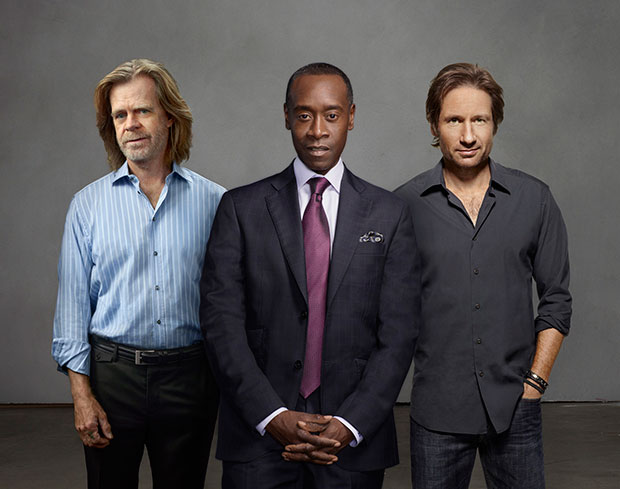
January is a debaucherous month at Showtime. After all, it's when the network’s trio of serially addicted men — Frank (William H. Macy) on Shameless, Marty (Don Cheadle) on House of Lies, and Hank (David Duchovny) on Californication — all return to the pay-network to get back to the business of being bad. So it's quite fitting that Showtime is labeling Jan. 13, the date that all three shows begin their new seasons, “Sinful Sunday."
But while we’ve got a serial drinker in Frank, a career liar in Marty, and a compulsive fornicator in Hank, the characters are hardly just sinners. Fans of the three series would agree with President of Entertainment at Showtime, David Nevins, who notes Frank, Marty, and Hank are far more layered than your average bad boys. “We try to make sure that all of our characters have a real complexity to them, and that goes for both men and women,” he says.
So while Macy, Cheadle, and Duchovny's roles are characters that could likely only exist on a network like Showtime, Sunday's well-rounded trio impossible to pigeonhole. “I think [Macy and Cheadle] are making full human beings,” Duchovny says. “Across the board, [these characters are] human.” That's likely what makes House of Lies the top performing comedy on Showtime, according to Nevins. It's also probably what brings fans of Hank Moody back season in and season out and keeps Shameless fans — a notoriously obsessive set — as rabid as ever for more Gallagher family hijinks. Of course, each of the series' leading men have their own ideas about what keeps the fans coming back for more.
Your Friendly, Neighborhood Rascal: Shameless's Frank Gallagher
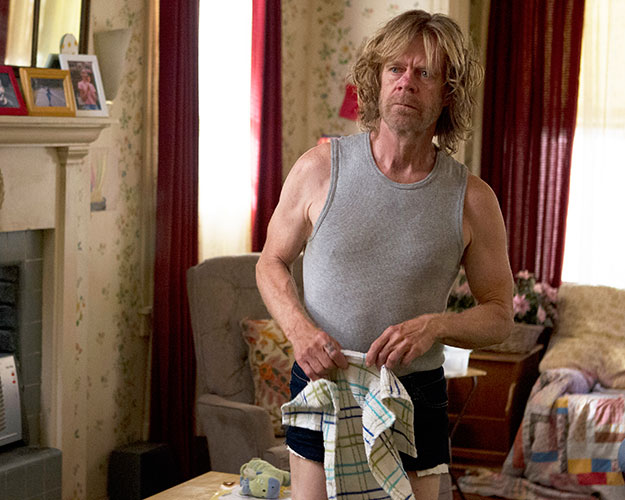
As the patriarch of Shameless’ Gallagher family, Frank isn’t exactly the poster child for father of the year. The perpetually drunk (or, at the very least, tipsy) South Side Chicago native is a man only his family (and Macy... and Shamelessfans everywhere) could love. Macy gets that, and it’s what makes his job so challenging. “This is my take on Frank,” he says. “He’s smart, he’s funny, he’s got a wicked sense of humor. He sees the irony of life and so he holds things somewhat lightly, but he’s very hard-working, entrepreneurial, and dogged. He never gives up.”
RELATED: 'Shameless' Star Shanola Hampton Spills Season 3 Details
Of course, that’s not exactly what most people would say about Frank, who ended last season asleep in the Chicago snow after punching his son Ian (Cameron Monaghan) over a case of Old Style beer. “I like the guy. [Laughs] But at the same time, he’s deplorable,” says Macy. “If I do my job right [the audience] will have enough forgiveness in them and the next week they’ll tune in again.”
So the audience may continue to come back for more, but what about the Gallaghers themselves? At the end of Season 2, they seemed to have had it with Frank. But all is not lost — Fiona (Emmy Rossum) and Co. may be a wild bunch, but when it comes down to it, they’re family. “I happen to know the family is not done with Frank, nor will they ever be done with Frank,” Macy says. “As perplexing as it is, even to me, there’s a part of it I find very moving. We say blood is thicker than water and that family trumps all, but the Gallagher family is living proof of that."
And heading into Season 3, Frank faces a few additional challenges beyond his own addictions. “At the end of this next season, he’s got some health issues … he bears his health problems stoically,” Macy says.
So it seems, even Frank can figure it out when the straights become dire. Macy’s not hoping Frank gets it allfigured out though. “I’ve got the role of a lifetime," he says. "At first [my scenes] are uncomfortable and icky, but if I just [bring] up [my] courage and throw [myself] into the scene as Frank would do, oh boy, I feel like the king of the world."
House of Lies and Marty, King Con of The Corporate World
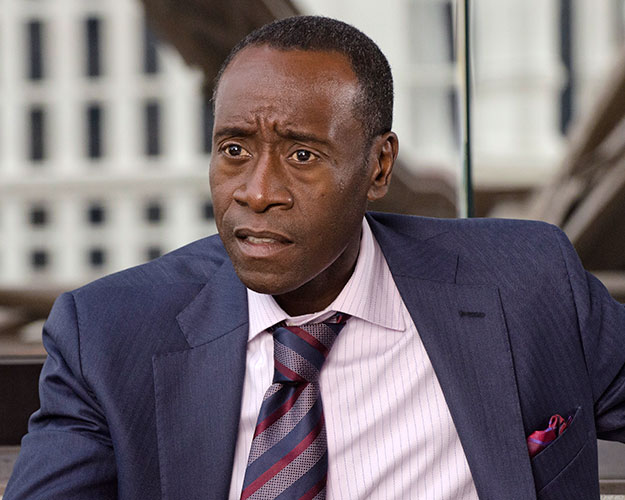
Sinful Sunday's youngest member is the sophomore series House of Lies, produced by and starring Cheadle as Marty Kaan, a leader in the ruthless, opportunistic world of management consulting. Together with the rest of his pod — or team of consultants — he swindles his way into deals with major corporations, but such a ruthless existence has its consequences outside of the office.
But those consequences have led to success for the network and Nevins, who boasts House of Lies as the “strongest comedy on our schedule, ratings-wise.” “It just feels like this show is starting to happen,” Nevins says. Even Macy admits he’s a fan, albeit a jealous one: “Cheadle is just great, but he should pay themto do that role,” he says. Indeed, Cheadle is enjoying the freedom of starring on a Showtime series. “There’s definitely a style of writing that appears on cable that definitely doesn’t happen anywhere else … definitely not on network television and unfortunately, not any more really in the movies, a lot of times,” Cheadle says.
According to the critically beloved actor, his series steps outside the boundaries of most other cable and pay-cable series. “I don’t know a lot of shows that deal with cross-gender kids and deal with parents and how to talk about that, and I don’t see a lot of [Marty’s son] Roscoe and not a lot of black leads in anything, so I think we were just able to stretch out in ways that are a little different,” Cheadle says.
Season 2 is also going to allow the characters themselves to stretch, now that the ordeal of explaining the giant world of management consulting has been dealt with in Season 1. “We’re getting to know everyone a little better,” he says. “We’re getting deeper and more nuanced … bringing in elements of race. [And] one of our characters deals directly with the Occupy [Wall Street] issue."
Of course, social politics add dimension, but fans of the show are likely waiting in fitful anticipation to see what happens between Marty and Jeannie (Kristen Bell) after last season's finale, during which she broke up with her fiance and the narrative hinted that it had something to do with her hooking up with Marty. Cheadle says Season 2 will have some serious work to do in sussing out what it all means for their relationship after their implied moment: “Well, we’re definitely trying to figure out what happened between Marty and Jeannie. Is this the start of something?”
After all, that's a question that lingered throughout the show's first season. The duo has spent 12 episodes flipping back and forth between potential romance and potential mutual destruction. “I think they clearly had this love, this strange dynamic between them of partners, and friends, and adversaries," Cheadle says. Of course, the actor won't tell us exactly where Marty and Jeannie will find themselves once they broach the love subject, or whether or not that hint in the season finale was a giant tease. We’re not that lucky.
Hank Moody, The Californicat-or
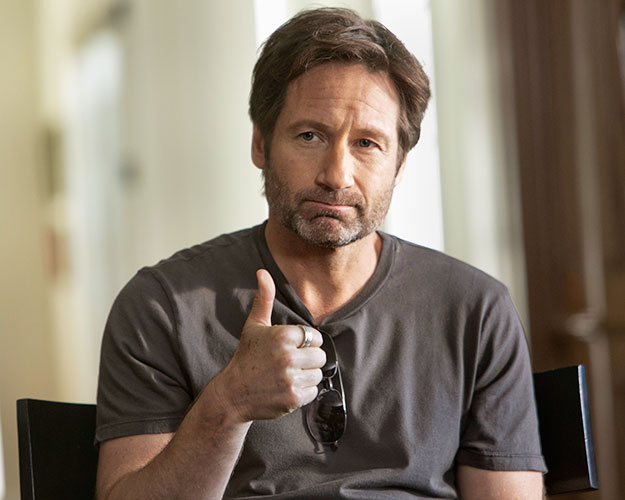
Last, but not least, comes Duchovny’s seasoned Showtime vet Hank Moody, the champion fornicator of Los Angeles. Over the five years we’ve known Hank, we’ve followed him through his life as a writer in Los Angeles: He wrote a book, taught some college classes, stood trial for statutory rape, wrote a movie for Rza of the Wu Tang Clan, and now, in Season 6, he will take a stab at writing a musical. Clearly, nothing is off limits for Hank. But, of course, despite Hank's many talents, his main draw will be the series' original peg: his apparent sex addiction.
Of course, as he embarks on year six of Moody’s chronicles, Duchovny wants to make it known that Hank is more than a rapscallion. “I tend not to think of [Hank] with one flaw, but as flawed. And by flawed, I mean human,” he says.
Despite his seemingly unwieldy life, Hank is always brought back to earth by some circumstance or consequence for his actions. It’s a cycle that works for him... and for Duchovny, who’s not looking to morph Hank into something he’s not to keep the show “fresh.” "I think it’s a temptation over a long-running series to try to reinvent the character, when in fact the character is the essence of the show,” Duchovny says. “If you change the character and reinvent it, you’re actually making a different show. As fun as it may be for the actor, it’s kind of a dissolution of the bond you’ve made with your audience,” he adds.
And that’s why, time and again, Hank goes through his own form of “reinvention,” according to Duchovny. “The touchstone for Hank instead of reinvention is to come back to the original relationship [with Karen and Becca]… It’s a rediscovery of what’s most important to the characters.”
Heading into Season 6, that’s exactly where we’ll find Hank, who’s just survived his crazy girlfriend’s attempted double suicide. “This year picks up with him getting physically better in the first episode,” Duchovny says.
If we know anything about Hank, it’s that he seems to be able to survive anything. And his reward, this year, is a little time with guest star Marilyn Manson, who Duchovny says got on the show by emailing with the creator Tom Kapinos. “[Manson’s] a fan of Hank’s and Hank’s a fan of Manson,” he says of the rocker’s two-episode stint in which he plays himself.
And while Duchovny’s excited about the guest star, he’s mostly excited to be back. “If we weren’t brought back, then that would have been the end of the show — Hank would have been killed by his crazy lover,” he says.
Luckily for Duchovny, and for his fans, Hank Moody doesn’t go down that easily.
Sinful Sundays … And Beyond
Sundays are loaded up with plenty of laughs and drama starting in winter, and the success of shows like Shameless, House of Lies, and Californication will only lead to more off-the-wall content on the network, like the upcoming Showtime series Ray Donovan, about a professional “fixer” for wealthy families, and Masters of Sex, about the pioneers of the science of human sexuality, airing sometime in 2013. “I feel an enormous sense of freedom and opportunity right now [because] the best people in the business want to be making shows on television," Nevins says. "We’re reaping the benefits."
Lucky for audiences, we all share in that bounty, too.
++++++++++++++++++++++++++++++++++++++++++++

Aimee Teegarden prepare for “The Curse of Downer’s Grove”
January 30, 2013 | Posted by Rebecca Lewis
Based on Michael Hornburg’s novel of the same name, Till will take the lead role as a high school senior who begins to get paranoid over an apparent curse that takes the life of one student every year at the school. Martini co-wrote the script with Bret Easton Ellis and the film will begin production in Los Angeles this February.
Since filming on critically acclaimed TV show “Friday Night Lights” ended, Teegarden has been slow in making a name for herself in Hollywood, taking a role early last year “Life At These Speeds” with Douglas Booth and “Love and Honor“
* The movie has been in the pipeline for a while now with Nelson McCormick once attached to direct and various female stars (Hayden Panettiere and Nikki Reed) considered and discarded for the role of Chrissie Swanson and her boy-crazy sexpot best friend,Tracy.
Yet to be determined the role Aimee is optioned for. Chrissie has a rather sexy but brief make out session (breasts exposed) in the book and I don't see how randy boy Bret Easton Ellis wouldn't have added it in the script. In fact don't be surprised if BEE written couple of gratuitous sex scenes or nude scene involving the girls. This will be cutie pie Aimee first real racy role either way.
++++++++++++++++++++++++++++++++++++++++++++
purple INTERVIEW : S/S 2013 issue 19
DRAKE BURNETTE
interview and portrait by ALEXIS DAHAN
 DRAKE BURNETTE is the beguiling, long-legged lead of Larry Clark’s new film Marfa Girl. With a background in art history — not in acting — the 26-year-old Austin native planned on applying to graduate school until a spate of good fortune forced her to reconsider. After wrapping Marfa Girl, Drake moved to Brooklyn, signed with DNA Models and is following her star where it takes her.
DRAKE BURNETTE is the beguiling, long-legged lead of Larry Clark’s new film Marfa Girl. With a background in art history — not in acting — the 26-year-old Austin native planned on applying to graduate school until a spate of good fortune forced her to reconsider. After wrapping Marfa Girl, Drake moved to Brooklyn, signed with DNA Models and is following her star where it takes her. ALEXIS DAHAN — So how did you end up working on Larry Clark’s film in Marfa?
DRAKE BURNETTE — Larry and I have a mutual friend named Jim Lewis who co-wrote the story for Kids with Larry. Jim and I were just e-mailing back and forth about books and then he was like, “Oh, by the way, this casting happened. I thought of you and you weren’t here, are you interested?” And I said yes. I guess they had cast somebody else, but for whatever reason they were not happy with her. It all happened in like 48 hours.
ALEXIS DAHAN — Did you know a lot about Larry Clark beforehand?
DRAKE BURNETTE — Yes. I’m not an expert on him, but I had seen all of his films, except for Another Day in Paradise. And I was familiar with his photography. I had a copy of Tulsa. I never studied photography, but I understood how he really changed what could be considered fine art photography. I was familiar with his themes of youth and innocence, and experience and tragedy, that sort of thing. I think he’s unabashedly interested in youth and revealing what are maybe ugly truths about youth — and also beautiful things about those ugly truths.
ALEXIS DAHAN — What are the beautiful things?
DRAKE BURNETTE — He just has an amazing eye. I find his work interesting because it looks good, but there’s more to it than just a beautiful boy or a couple embracing or something like that. I think he’s interested in relationships and that span of time when, as a youth, you don’t know everything but you’re excited and exploring, and sometimes there are consequences to that exploration.
ALEXIS DAHAN — What was it like working with Larry Clark?
DRAKE BURNETTE — I really enjoyed it. It was a really exciting and collaborative process, fleshing out the script that he had written and bringing it to life. I was able to bring in my own personal experiences to feed this authenticity that he was interested in. And I think that was one of the reasons that he cast me; I was familiar with Marfa. I knew people here and I’ve had experiences here, so I was able to bring that to the film.
ALEXIS DAHAN — What is your experience with Marfa?
DRAKE BURNETTE — I’m not from Marfa, but I feel very drawn to this place and very connected to it, so I’ve come here many times for music, for shows, for art, or just to get away. And so, through those experiences, I’ve gotten to know other people who like to come here, who come to visit. I’ve also gotten to know people who are actually from here. And so I know how sensitive it is to have this small community constantly have this influx of outsiders who come and leave. I understand the complications that arise when there are visitors that are often more well-to-do, who come here and are like “Oh, it’s so lovely.” But then there are the people who live and work here. Maybe they work in restaurants, maybe they come from a ranching family, maybe they just get by, and all these people are interacting with each other on a more intimate level just because the town is so small.
ALEXIS DAHAN — Why do you think Larry Clark chose Marfa?
DRAKE BURNETTE — I think it’s a two-part answer. A lot of people find the landscape stunning and very peaceful, and there is something magical about it. And then just the geographical location, being so close to the border, being in West Texas. Having this whole history of Texas culture, ranching and then the Judd Foundation. There’s a whole category of West Texas films that are all pretty radical and have been filmed in and around this area. I think it’s a combination of these things.
ALEXIS DAHAN — You are the Marfa Girl of the title?
DRAKE BURNETTE — That’s my character. She is an outsider who comes from a privileged place. She makes art and is very curious about the world, but she is also naive. Larry was really interested in her back-story. She comes from a hippie family, where she was encouraged as a child to participate in free love, but I think those ideas are, for her character and for her family, half-formed. She hasn’t thought it all the way through. So she’s sort of a naive feminist. Though she feels very strongly about actively pursuing a lifestyle that expresses her ideals of free love and art and all of that, she’s almost silly. But she’s also genuine and kind of lost.
ALEXIS DAHAN — Was there tension or drama on the set?
DRAKE BURNETTE — Considering maybe half of the cast were non-professional actors, myself included, there wasn’t very much drama. There were moments of awkwardness or misunderstanding between myself and a couple of other people, but those were quickly resolved. There was some drama because the town is so small, and once word got out that Larry Clark was shooting a film and people got on Google and figured out who he was, we lost some location possibilities. They didn’t want him shooting in their school and that sort of thing. But Larry was very focused. He’s really healthy. He had this compulsion to make this film and try to capture his impression of this town, because something captivated him there. It’s not like we were all raging back at Larry’s place at the end of the day. Everybody was pretty focused.
ALEXIS DAHAN — What was your favorite interaction with Larry?
DRAKE BURNETTE — On the third or fourth day, we shot my first love scene. And obviously I’ve never shot a love scene before. Everybody was like, “Phew, here we go.” Shooting started at like seven or eight in the morning, and so I had to get on set by like six. I’m not a morning person. It was cold and everybody was in a really bad mood. This was the vibe gearing up to shoot this scene that was supposed to be hot, you know, at like the ass-crack of dawn. I started my period that morning as well, and so I was just like, fuck, this sucks. Why am I doing this? I’m in hair and make-up getting ready and Larry comes up to me and says, “Hi, how’s it going?” I’m like, “It’s fine.” He could sense I wasn’t happy, so he asked, “How are you feeling about this?” I was like, “I’m feeling fine, I just want to get it done.” He was like, “OK, well, are you on your period?” And I was like, “How did you know?” And he was like, “You’re fucking kidding me.” And I was like, “No! It started this morning. I’m pissed about it.” He started laughing and launched into this story about how on almost every film he’d ever shot, the actress always started her period on the day they had to shoot the love scene. He went through several stories of different actresses starting their period and being bloated and having to deal with all of that, and so it was this lovely moment where he made me laugh and he was being really fatherly. It just made me relax.
ALEXIS DAHAN — What are the things that you would want to keep doing?
DRAKE BURNETTE — I’m figuring that out right now. Originally I thought I would go to graduate school, but now this has kind of made me reconsider it. I know the work I’ve done that has been the most enjoyable to me has always been a collaborative process with other people. It was either with friends or people who became friends. That to me is the most interesting and most enjoyable way to live and work.
++++++++++++++++++++++++++++++++++++++++++++DRAKE BURNETTE — I think it’s a two-part answer. A lot of people find the landscape stunning and very peaceful, and there is something magical about it. And then just the geographical location, being so close to the border, being in West Texas. Having this whole history of Texas culture, ranching and then the Judd Foundation. There’s a whole category of West Texas films that are all pretty radical and have been filmed in and around this area. I think it’s a combination of these things.
ALEXIS DAHAN — You are the Marfa Girl of the title?
DRAKE BURNETTE — That’s my character. She is an outsider who comes from a privileged place. She makes art and is very curious about the world, but she is also naive. Larry was really interested in her back-story. She comes from a hippie family, where she was encouraged as a child to participate in free love, but I think those ideas are, for her character and for her family, half-formed. She hasn’t thought it all the way through. So she’s sort of a naive feminist. Though she feels very strongly about actively pursuing a lifestyle that expresses her ideals of free love and art and all of that, she’s almost silly. But she’s also genuine and kind of lost.
ALEXIS DAHAN — Was there tension or drama on the set?
DRAKE BURNETTE — Considering maybe half of the cast were non-professional actors, myself included, there wasn’t very much drama. There were moments of awkwardness or misunderstanding between myself and a couple of other people, but those were quickly resolved. There was some drama because the town is so small, and once word got out that Larry Clark was shooting a film and people got on Google and figured out who he was, we lost some location possibilities. They didn’t want him shooting in their school and that sort of thing. But Larry was very focused. He’s really healthy. He had this compulsion to make this film and try to capture his impression of this town, because something captivated him there. It’s not like we were all raging back at Larry’s place at the end of the day. Everybody was pretty focused.
ALEXIS DAHAN — What was your favorite interaction with Larry?
DRAKE BURNETTE — On the third or fourth day, we shot my first love scene. And obviously I’ve never shot a love scene before. Everybody was like, “Phew, here we go.” Shooting started at like seven or eight in the morning, and so I had to get on set by like six. I’m not a morning person. It was cold and everybody was in a really bad mood. This was the vibe gearing up to shoot this scene that was supposed to be hot, you know, at like the ass-crack of dawn. I started my period that morning as well, and so I was just like, fuck, this sucks. Why am I doing this? I’m in hair and make-up getting ready and Larry comes up to me and says, “Hi, how’s it going?” I’m like, “It’s fine.” He could sense I wasn’t happy, so he asked, “How are you feeling about this?” I was like, “I’m feeling fine, I just want to get it done.” He was like, “OK, well, are you on your period?” And I was like, “How did you know?” And he was like, “You’re fucking kidding me.” And I was like, “No! It started this morning. I’m pissed about it.” He started laughing and launched into this story about how on almost every film he’d ever shot, the actress always started her period on the day they had to shoot the love scene. He went through several stories of different actresses starting their period and being bloated and having to deal with all of that, and so it was this lovely moment where he made me laugh and he was being really fatherly. It just made me relax.
ALEXIS DAHAN — What are the things that you would want to keep doing?
DRAKE BURNETTE — I’m figuring that out right now. Originally I thought I would go to graduate school, but now this has kind of made me reconsider it. I know the work I’ve done that has been the most enjoyable to me has always been a collaborative process with other people. It was either with friends or people who became friends. That to me is the most interesting and most enjoyable way to live and work.
Once Upon A Time's Sarah Bolger And Others Auditioning For Endless Love Remake

It’s a frightening time for movies when “remakes of adaptations” garner just as many headlines as everything else. Such is the case with Universal’s Endless Love, a remake of the Franco Zeffirelli’s 1981 multi-Razzie Award nominee starring Brooke Shields and Martin Hewitt, itself based on Scott Spencer’s popular novel of the same name, though many of the changes made for the film added melodramatic weirdness that Spencer never intended. Let’s hope it’s better to remake the bad stuff than the good.
According to The Hollywood Reporter, five actresses are being flown out to Hollywood to read for the role of Jade, which Shields previously played, with director Shana Feste, writer-director of Country Strong and The Greatest.
The names include Gabriella Wilde, from the recent Three Musketeers remake and the upcoming Carrie remake (Do you see a pattern here?); Sarah Bolger, from Once Upon a Time and The Tudors; Sophie Lowe, an Australian actress who was in the controversial and enjoyable series The Slap, also a novel adaptation; and Olivia Cooke, who will star in the upcoming Bates Motel TV series, as well as the poltergeist horror The Quiet Ones. I guess Bates Motel isn’t quite a remake or an adaptation, but that doesn’t make it necessary. The studio was interested in Mirror Mirror’s Lily Collins as well, but she’ll already be filming Christian Ditter’s Love Rosie.
The actresses will be reading with Australian actor Brenton Thwaites, who has upcoming roles in Maleficent, the dark take on Sleeping Beauty with Angelina Jolie, and the horror Oculus. Thwaites doesn’t necessarily have the role yet, but producers like him, and are looking for chemistry between him and the actresses. Though the young leads are mostly unknown, studio insiders say the star power will come when the parents are eventually cast.
I leave it up to you, dear readers, to predict which of today’s pop stars will inevitably remake the classic Diana Ross – Lionel Richie theme song from the film, where the timeless lines “You’re every step I make” were sung.
* sounds like a PG-13 crap. Even the original was a watered down version compared to the novel despite the R-rating. But on the bright-side, it looks encouraging when they are looking to cast foreign talents which suggest possibility of nudity. Hopefully Sarah Bolger gets the part. She was pretty loud against on-screen sex/nude scenes in an interview.
++++++++++++++++++++++++++++++++++++++++++++
 Wild, powerful and sensual! Just what we like. And what Kesler Tran is offering once more with this beautiful black and white shot where he captured Jennifer McManis @ Jennifer McManus on a rollercoaster of emotions. And we are following her as you just cannot escape from the intriguing spell they put over you. Sublime!
Wild, powerful and sensual! Just what we like. And what Kesler Tran is offering once more with this beautiful black and white shot where he captured Jennifer McManis @ Jennifer McManus on a rollercoaster of emotions. And we are following her as you just cannot escape from the intriguing spell they put over you. Sublime!++++++++++++++++++++++++++++++++++++++++++++
Banshee's Greg Yaitanes Answers Our Showrunner Survey

TV Guide Magazine: I've got room in my life to watch one more show. Why should it be yours?
Greg Yaitanes: There's always room for dessert. Banshee is a delicious mix of sex, action and drama.
TV Guide Magazine: Who should be watching?
Yaitanes: Anyone digging Breaking Bad, Homeland, Sons of Anarchy or The Wire. Fans of action films and graphic novels. Every single member of my family.
TV Guide Magazine: What happens if we don't watch your show?
Yaitanes: You're missing out. Banshee's 10 episodes will take you on a very satisfying journey. We do in one season what most shows drag out for five. It's packed.
TV Guide Magazine: Give us an equation for your show.
Yaitanes: Witness plus Warrior times Tarantino minus the boring parts of No Country for Old Men divided by Sex and Lucia minus Lucia.
TV Guide Magazine: What's the best thing anyone has said or written about Banshee?
Yaitanes: That it's the perfect blend of character and genre and not like anything on TV right now.
TV Guide Magazine: What's the worst thing?
Yaitanes: "What's Banshee?"
TV Guide Magazine: What's an alternate title?
Yaitanes: Downton Abbey. But we couldn't use it for obvious reasons.
TV Guide Magazine: Come up with a premise for the spin-off.
Yaitanes: We have it. It's called Banshee: Origins, and it's an online series along with a graphic novel of the show's backstory.
TV Guide Magazine: What credit of yours would you prefer we forget?
Yaitanes: The pilot to Cleopatra 2525.
TV Guide Magazine: Amish TV is hot right now. Tell me something unique about your Amish characters.
Yaitanes: Two words: "Amish gangster."
TV Guide Magazine: If you weren't producing this show, what series would you most like to be an executive producer on?
Yaitanes: Family Guy. Seth MacFarlane and his writers are fearless.
TV Guide Magazine: Why is your cast the best on television?
Yaitanes: It's a largely European cast playing Americans, which I had very good luck with when I was executive producing House with Hugh Laurie.
TV Guide Magazine: Let's scare the network. Tell us an idea that didn't make it to the screen.
Yaitanes: The great thing about pay cable and working for Cinemax is there is no scaring them.
TV Guide Magazine: Pick another show to start a fake feud with.
Yaitanes: We shoot Banshee across the street from Homeland and will thrown down on softball anytime.
What show would you like to do a crossover episode with, and how would that go?
Yaitanes: The Sopranos. Tony and the gang would fit right in. That's the bar we hold ourselves to and hope people engage [with] and discover Banshee.
TV Guide Magazine: How will your show change the face of TV as we know it?
Yaitanes: By embracing multiple media platforms from our inception, Banshee will redefine TV in terms of "trans-media," meaning there are multiple platforms and layers to enjoy and engage the show on. I'd urge that anyone watching makes sure to watch the title sequence carefully since it changes every week and to stay for the end credits since there is something waiting for you at the very end of each episode.
++++++++++++++++++++++++++++++++++++++++++++
some notable nudes from Purple Mag 2013[issue 19]
Italian model Natalia Bonifacci asleep at the Chateau Marmont
Anja Rubik
Iekeliene Stange
Eliza Cummings
Ehren Dorsey
Daria Werbowy
++++++++++++++++++++++++++++++++++++++++++++
HBO Is Moving Forward With Damon Lindelof and Tom Perrotta’s Drama The Leftovers
++++++++++++++++++++++++++++++++++++++++++++
Oscar-Nominee Jennifer Lawrence Is In a League of Her Own
By Jenelle Riley
“I had a total fan-girl geek-out,” Lawrence says, reveling in the experience. “I’m such a huge fan of hers; I kind of got really insane and put my arm around her neck. I forget I’m much bigger than other people, and I probably half strangled her.”
Meeting a personal hero is just another part of a good week for Lawrence. The day before, she earned her second Oscar nomination and picked up two Critics’ Choice Awards, one for playing the Girl on Fire in “The Hunger Games” and one for playing the girl who dances with Bradley Cooper in “Silver Linings Playbook.” In two days, she will win a Golden Globe Award for the latter. Perhaps the biggest testament to her newly minted it-girl status: In a week she will be hosting “Saturday Night Live.” It’s a lot to take in, let alone for a 22-year-old self-proclaimed “dork” from Louisville, Ky. So let’s go right to the source and ask Lawrence: What is it like to be her right now?
“Confusing,” Lawrence says, then lets loose a long laugh. “You know when something is just too much to take in and there’s only a certain amount you can absorb as a human? Last night Daniel Day-Lewis and Tommy Lee Jones were sitting next to my table, and I was like, ‘I can’t process this right now. So I’m just going to turn away.’ ”
Much has been made of Lawrence’s uncensored, refreshing attitude, a willingness to not take herself too seriously. Today is no exception, as she demonstrates the one imitation she says she can pull off—Michael McDonald—by singing a few bars from “What a Fool Believes.”
What is serious is her talent; few actors can hold their own with Robert De Niro, not to mention steal a scene from him. Lawrence so consistently disappears into her roles that it’s difficult to believe she is only 22. Perhaps even more difficult to fathom is that she could get even better. As “The Hunger Games” director Gary Ross told Backstage, “I don’t think she has any peers in her generation. I think we’re seeing the infancy of what’s going to be a huge, huge career, a historic career.”
Lawrence might be at the top of every director’s list, but she has had to fight for her most iconic roles. Her initial discovery is the stuff of fairy tales; she was visiting New York on spring break with her family at age 14 when a photographer asked to take her photo. Modeling agencies began calling, and “we didn’t really have anything better to do,” so she met with some.
“On the cab ride to my first meeting, I decided in my 14-year-old head I was going to be an actress,” Lawrence says. “I had never once thought of it before, really.” Her mother, Karen, helped her keep a level head. “I was being offered contracts, and my mom told me they were blowing smoke up my butt—her exact words—and just wanted my money.” But on returning to Louisville, Lawrence began begging her parents every day. That summer her mother took her to New York to try it out. “She was probably hoping I would fail and get it out of my system,” Lawrence says. “And it just kind of kept snowballing, out of control.”
Commercials (including a promo for MTV’s “My Super Sweet 16” that earned her her SAG card, as she revealed in her 2013 SAG Award acceptance speech) and a role on “The Bill Engvall Show” followed, and Lawrence broke into movies with two powerful roles in little-seen films in 2008, “The Burning Plain” and “The Poker House.” But it was her turn as tough, wise-beyond-her-years Ree Dolly in 2010’s “Winter’s Bone” that changed everything.
At first, writer-director Debra Granik didn’t want to cast Lawrence, regarding her as too pretty. When casting moved to New York, Lawrence took a redeye and refused to sleep on the plane.
“I didn’t shower or brush my hair, just went in to the audition,” she says. “I ended up looking just bad enough that they gave me the part.”
She also auditioned for “The Hunger Games,” an experience Ross says “was like no audition I’d ever seen. It was one of the most powerful acting experiences I’d ever had.” And she auditioned for the role of outspoken widow Tiffany in “Silver Linings” over Skype, something the “least technologically inclined person in the world” hadn’t done before. Writer-director David O. Russell says Lawrence came in late in the casting process and simply blew away the competition, despite that in Matthew Quick’s book, Tiffany is in her 30s. Even Lawrence says, “With ‘Silver Linings,’ I totally get why I had to audition—I was way too young for the part.” After she won the role, an addition was made to the script in which Cooper’s character asks her about her age. Though Russell says the line was added, he notes, “But once she became the character, her age never really felt like an issue because she has such a timeless quality.”
Lawrence says she prefers to audition. “Being offered a part is very nice, but there’s something about feeling like you really went in there and earned it,” she says. “Then in times of doubt, you know they saw something in you and hired you for a reason. Because I have many moments of doubt, and that’s always been very helpful.”
Also helpful is her secret weapon and biggest supporter, her mother.
“My mom is a literary genius,” Lawrence says. “She read ‘Winter’s Bone’ when I was 15 and said I should play the part. She read ‘Hunger Games’ before it was a big hit and turned me on to that.” Karen Lawrence was also responsible for two of Lawrence’s upcoming projects. She read Jeannette Walls’ memoir “The Glass Castle” and recommended it to her daughter, who has acquired the film rights. And she read the screenplays for “Ends of the Earth” by “Argo” scribe Chris Terrio, which Lawrence is now attached to star in and calls the “most amazing script I’ve ever read.” Says Lawrence, “She’s been offered jobs in the industry but just does it for fun. Which is great—because I’ve got her! And I don’t even have to pay her.”
Before anything else, Lawrence already has “Serena,” a period drama in which she reteams with Cooper, in the can. She has a few days left on the “Hunger Games” follow-up, “Catching Fire,” and will soon start shooting the sequel in her other franchise, “X-Men: Days of Future Past,” in which she reprises her role as Mystique. And then there’s Oscar night, which is just as sweet the second time around, particularly as three of her co-stars are nominated.
“I’m just thrilled to be in this movie with such an amazing cast,” she says. “I’ve never been through this; the last time, I kind of went through this alone and didn’t get to sit at the table with everyone from the movie. It’s a really incredible feeling.”
++++++++++++++++++++++++++++++++++++++++++++
Egyptian Prime Minister: Unclean Breasts Cause Diarrhea
Uh… Okay.In case you weren’t aware of it, Muhammad commands women to allow strangers to suckle their breasts:
Sahih Muslim, Book 008, Number 3428:
Zainab daughter of Abu Salama reported: I heard Umm Salama, the wife of Allah’s Apostle (may peace be upon him, saying to ‘A’isha: By Allah, I do not like to be seen by a young boy who has passed the period of fosterage, whereupon she (‘A’isha) said: Why is it so? Sahla daughter of Suhail came to [Muhammad] and said: [Muhammad], I swear by Allah that I see in the face of Abu Hudhaifa (the signs of disgust) on account of entering of Salim (in the house), whereupon [Muhammad] said: Suckle him. She (Sahla bint Suhail) said: He has a beard. But he (again) said: Suckle him, and it would remove what is there (expression of disgust) on the face of Abu Hudhaifa. She said: (I did that) and, by Allah, I did not see (any sign of disgust) on the face of Abu Hadhaifa.
Apparently, the Egyptian Prime Minister doesn’t want to get diarrhea as he goes around suckling all those breasts:
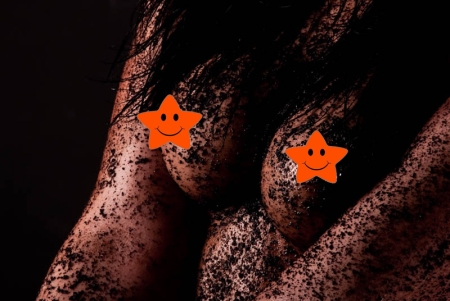
Women’s Unclean Breasts Cause Diarrhoea, Says Egypt Prime Minister Hisham Qandil
By VASUDEVAN SRIDHARAN – Via ww.IBTimes.co.uk
The inability of women in rural Egypt to clean their breasts is causing a diarrhoea epidemic, according to the country’s Prime Minister Hisham Qandil.
Qandil was speaking about the spate of recent epidemics in Egypt’s rural communities. During the address, he said he had witnessed children suffering from diarrhoea immediately after they have been breastfed because their mothers were unable to clean themselves probably.
He added that many women in rural Egypt don’t even bother to clean their breasts at all before feeding their toddlers.
Qandil made his remarks during an address at a cabinet meeting. Women members present were noticeably uncomfortable as Qandil made the comments.
++++++++++++++++++++++++++++++++++++++++++++
Showtime Gives Pilot Order To ‘The Affair’
 I’ve learned that Showtime has handed a pilot order to The Affair, a provocative relationship drama written/executive produced by playwright Sarah Treem (In Treatment) and executive produced by In Treatment creator Hagai Levi. Mark Mylod (Shameless) is attached to direct and exec produce the pilot, which dissects an affair and its effect on the two marries it disrupts, with the story told separately from the male and female perspective. Based on an original concept by Treem and Levi, The Affair centers on Noah, a married father of four, who becomes involved with Allison, a married woman mourning the loss of her child, after a chance meeting at the beach.
I’ve learned that Showtime has handed a pilot order to The Affair, a provocative relationship drama written/executive produced by playwright Sarah Treem (In Treatment) and executive produced by In Treatment creator Hagai Levi. Mark Mylod (Shameless) is attached to direct and exec produce the pilot, which dissects an affair and its effect on the two marries it disrupts, with the story told separately from the male and female perspective. Based on an original concept by Treem and Levi, The Affair centers on Noah, a married father of four, who becomes involved with Allison, a married woman mourning the loss of her child, after a chance meeting at the beach. ++++++++++++++++++++++++++++++++++++++++++++
model info courtesy of B.Sampson
 27-years old Talor Marion is a mainstream model who lists on her website that she was Miss Teen Denver and was a Denver Broncos cheerleader. All-American blonde (hoping carpet match the drapes) Talor can be found via her twitter, lips pursed modeling at ModelMayhem and istudio, on Facebook, spotlighted at Maxim, even has a IMDB credit thanks to her appearance on a crappy MTV show.
27-years old Talor Marion is a mainstream model who lists on her website that she was Miss Teen Denver and was a Denver Broncos cheerleader. All-American blonde (hoping carpet match the drapes) Talor can be found via her twitter, lips pursed modeling at ModelMayhem and istudio, on Facebook, spotlighted at Maxim, even has a IMDB credit thanks to her appearance on a crappy MTV show.The story of an American princess:
City: Evergreen
State: CO
Measurements: 34-23-34
Height: 5'8
Weight: 110
Eyes: Blue
Hair Color: Blonde
Things I Love: Outdoors, snow, men’s hands, cooking, sushi, and chocolate
Things I Hate: Sharks, meat, and cilantro
Hobbies: Snowboarding, dancing, running, pilates
Talor Marion was born on February 1, 1986 in Bedford, Texas, but raised in Evergreen, Colorado by her parents, Patrick and Lori Marion. This blonde model claims that there's more to see about her than her fake boobs. She developed an early love of snowboarding and dance. She became captain of her high school dance team and after graduation tried her hand – feet, actually – as a member of the professional arena football dance team, The Colorado Crush Girls. Her early success in beauty pageants also led her to modeling work, from Details magazine to Trashy Lingerie to Seven Til Midnight costumes. Segueing into acting, she recently appeared on “Entourage,” “CSI,” Spike TV’s “MANswers” and such feature films as Fast and Furious. This comely blue-eyed, blonde-haired sweetie hopes to become a female version of talk show host Howard Stern, but for now she’s too busy to be stuck behind a microphone, regularly traveling on business between Los Angeles, Miami and New York City. Talor was seen on MTV's reality TV dating show That's Amore! She was one of the fifteen women who lived with bachelor Domenico Nesci in an Italian place near Hollywood. The women competed against each other in a series of tests to prove that they were the right girl for him and to win his love. Talor was eliminated in episode 5.
* She talks about organizing a 'poker' all-girls group or agency and taking them to Vegas for a 'tournament'. I'll remind you guys not to confuse 'poker' with 'hooking'.
But long before all the high-profile attention she is enjoying right now (in her mind at least), Talor in true spirit patriot of our great nation also modeled for Playboy under the name of Talor Paige back in 2007.
You can find Ms. Paige here and here and here and here
 | |
| Personal | |
| Born: | February 1, 1986 |
| Ethnicity: | Caucasian |
| Body | |
| Measurements: | 34C-24-34 |
| Bra/cup size: | 34C (75C) |
| Height: | 5 ft 6 in (1.68 m) |
| Weight: | 108 lb (49 kg) |
| Body type: | Slim |
| Eye color: | Blue |
| Hair: | Blonde Long |
| Pubic hair: | Shaved |
* Filched the following links from a porn site
TALOR PAIGE : HQ PICTORIAL

Photo Type: JPG
Resolution: 1920 PIXEL ALONG THE LONG AXIS
Number of Photos: 25
Total Size: 6 MB
DOWNLOAD LINK: [1]
TALOR PAIGE : REAL AMERICAN GIRLS - HQ PICTORIAL + NAU HD 1080P EXN VIDEO

Video Type: MP4
Resolution: HD 1080P
Duration: 4 min 39 sec

Photo Type: JPG
Resolution: 1920 PIXEL ALONG THE LONG AXIS
Number of Photos: 26
Total Size: 231 MB
DOWNLOAD LINK: [2]
TALOR PAIGE : FRESH FACES SETS - HQ PICTORIAL + NAU HD 1080P EXN VIDEO

Video Type: MP4
Resolution: HD 1080P
Duration: 6 min 39 sec

Photo Type: JPG
Resolution: 1920 PIXEL ALONG THE LONG AXIS
Number of Photos: 29
Total Size: 306 MB
DOWNLOAD LINK: [3]
TALOR PAIGE : FRESH FACES SETS - HQ PICTORIAL + NAU HD 1080P INT VIDEO
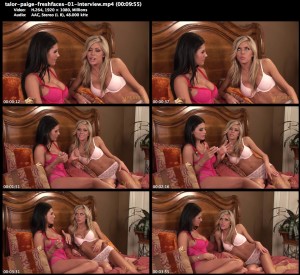
Video Type: MP4
Resolution: HD 1080P
Duration: 9 min 55 sec

Photo Type: JPG
Resolution: 1920 PIXEL ALONG THE LONG AXIS
Number of Photos: 25
Total Size: 467 MB
DOWNLOAD LINK: [4]
TALOR PAIGE : ALL AMERICAN SWEETIE
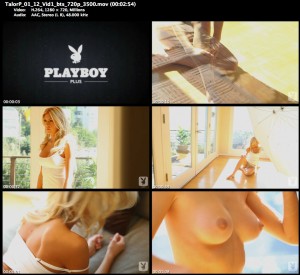
Video Type: MOV
Resolution: HD 1080P
Duration: 2 min 54 sec

Photo Type: JPG
Resolution: 1920 PIXEL ALONG THE LONG AXIS
Number of Photos: 44
Total Size: 105 MB
DOWNLOAD LINK: [5]
TALOR PAIGE : WILD ONE
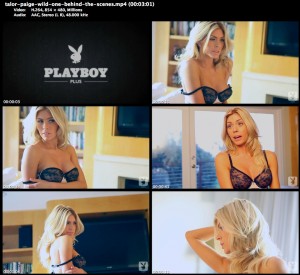
Video Type: MP4
Resolution: SD 480P
Duration: 3 min 01 sec
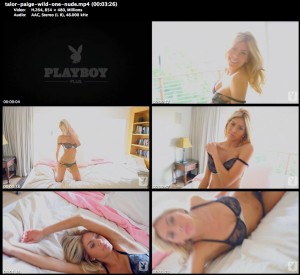
Video Type: MP4
Resolution: SD 480P
Duration: 3 min 26 sec
Total Size: 42 MB

Photo Type: JPG
Resolution: 1920 PIXEL ALONG THE LONG AXIS
Number of Photos: 43
Total Size: 51 MB
DOWNLOAD LINK: [6] and [7]
Password for all the files: aywkubttod
++++++++++++++++++++++++++++++++++++++++++++
++++++++++++++++++++++++++++++++++++++++++++
Starz Releases First Look at 'White Queen' (Video)
++++++++++++++++++++++++++++++++++++++++++++
You have read this article Aimee Teegarden /
Banshee /
Californication /
Jennifer Lawrence /
Kristen Stewart /
Odette Annable /
Sarah Bolger /
Selena Gomez /
Showtime' The Affair /
The White Queen
with the title stars, sex and nudity buzz : 02/08/2013. You can bookmark this page URL http://duk78.blogspot.com/2013/02/stars-sex-and-nudity-buzz-02082013.html. Thanks!





